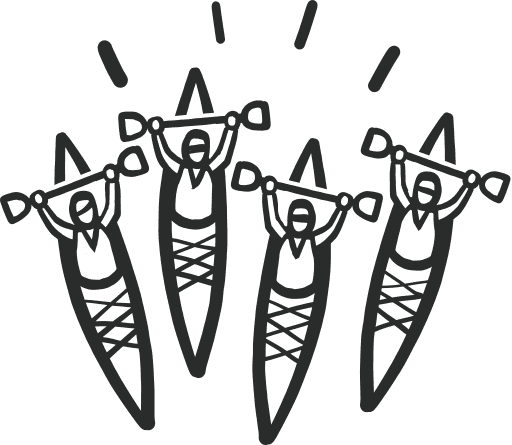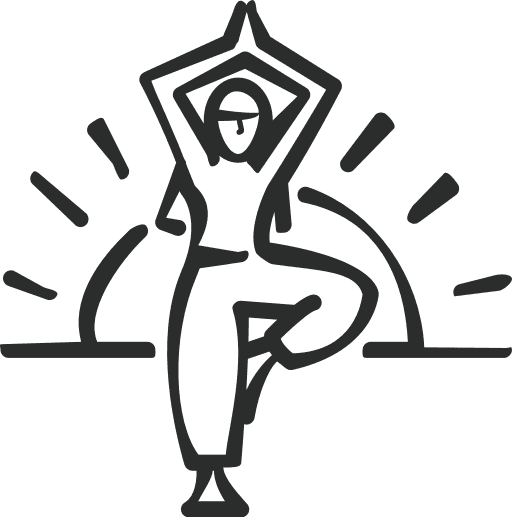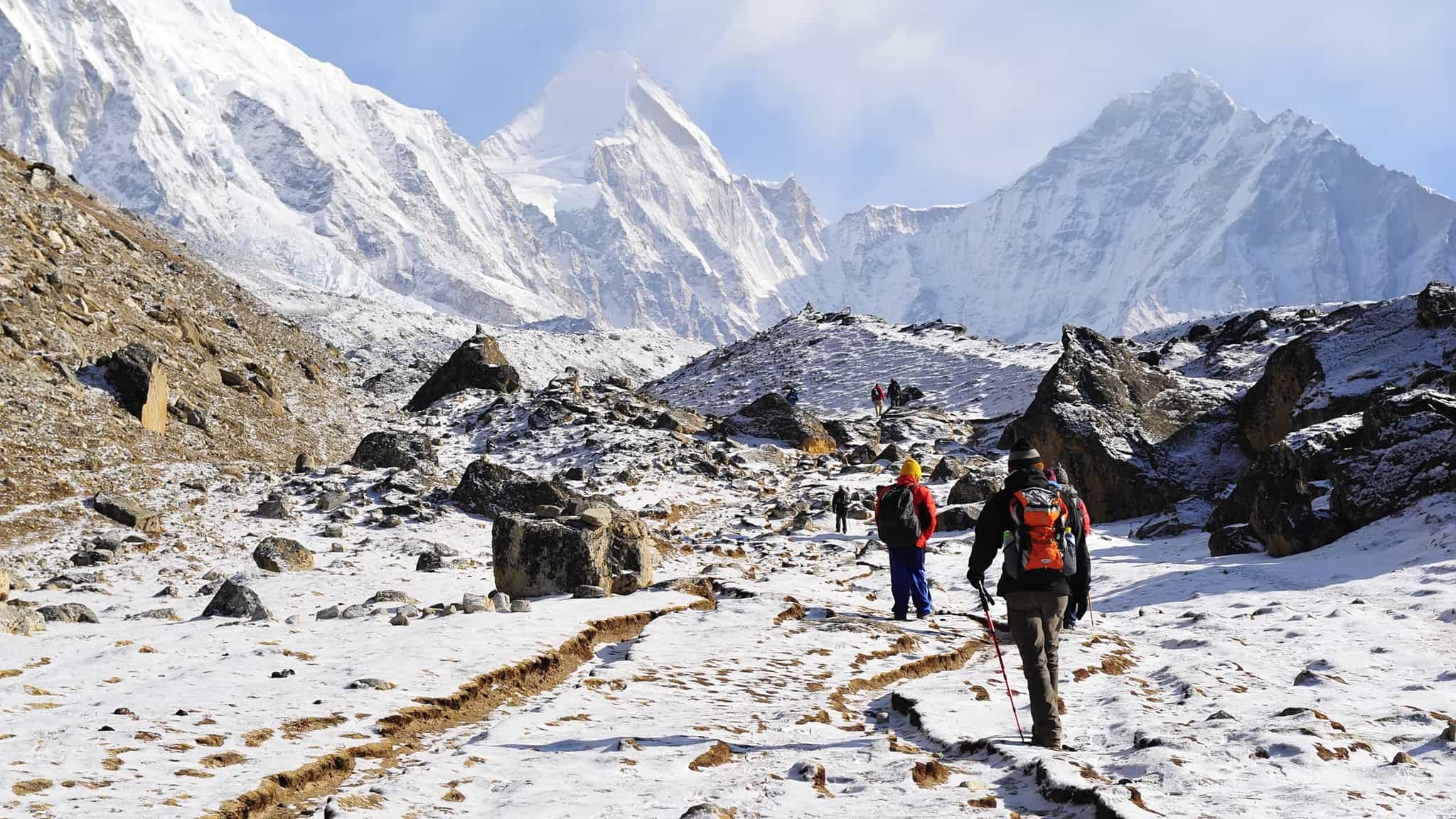
Trek to Everest Base Camp
Trek the famous trails to Everest Base Camp and follow in the footsteps of Edmund Hillary and Tenzing Norgay
What's Included?
Activities & Certified Guides
All itinerary activities with expert, local, English-speaking guidesAll accommodation
2 nights in a hotel in Kathmandu, 1 night glamping, 11 nights in teahouses on the trailMeals
2 breakfasts plus welcome and farewell dinners in KathmanduInternal Flights & Transfers
Internal flights from Kathmandu or Manthali to Lukla (and back); arrival & departure airport transfers; all local transfers throughoutPermits & Porterage
Porters to carry your luggage on the trek, plus all your entry fees and permitsSmall Like-minded Groups
Solo-friendly by design, join our small n’ sociable groups of up to 12 like-minded, active and outdoorsy people…
…
What's it like?




























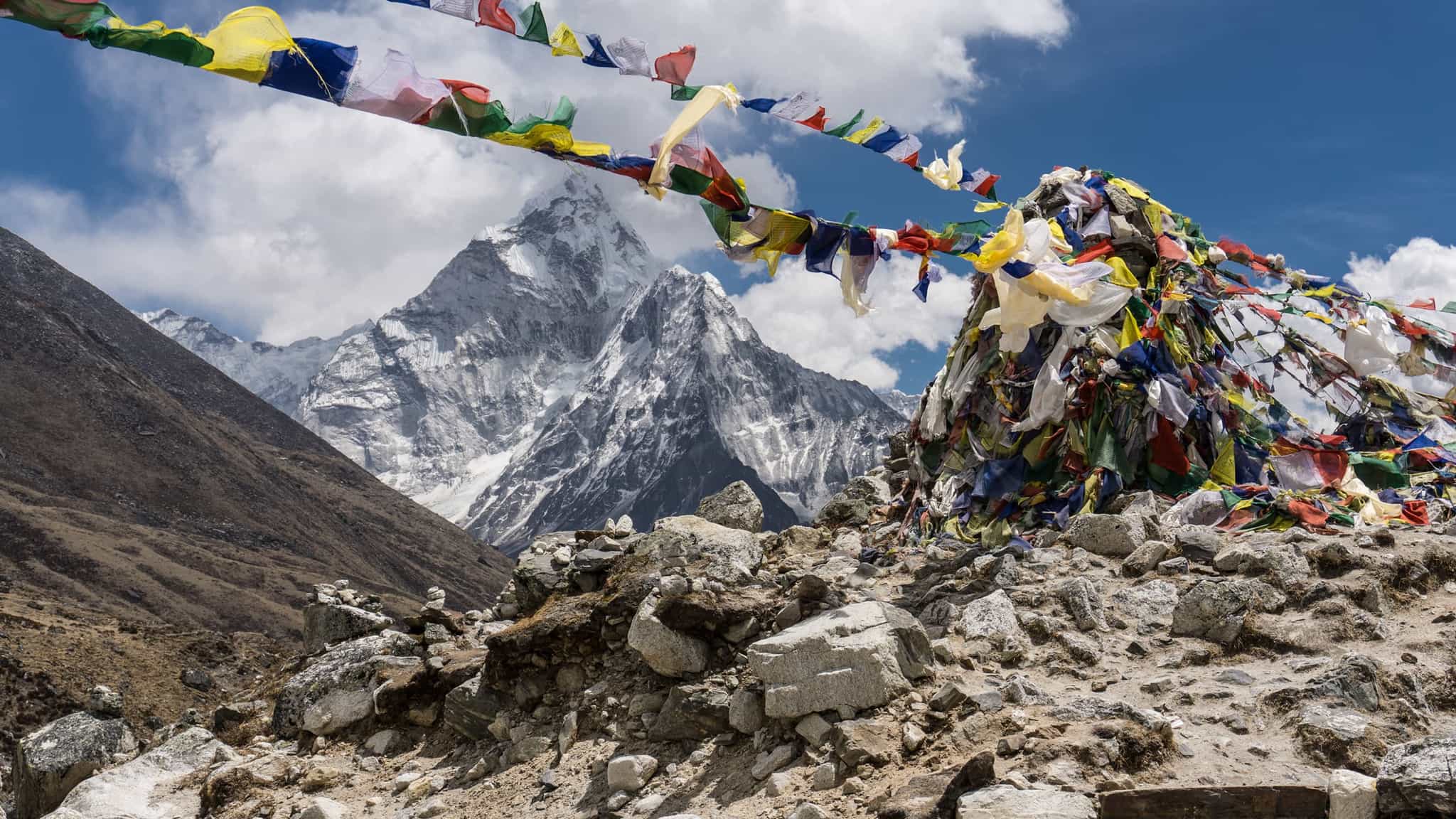
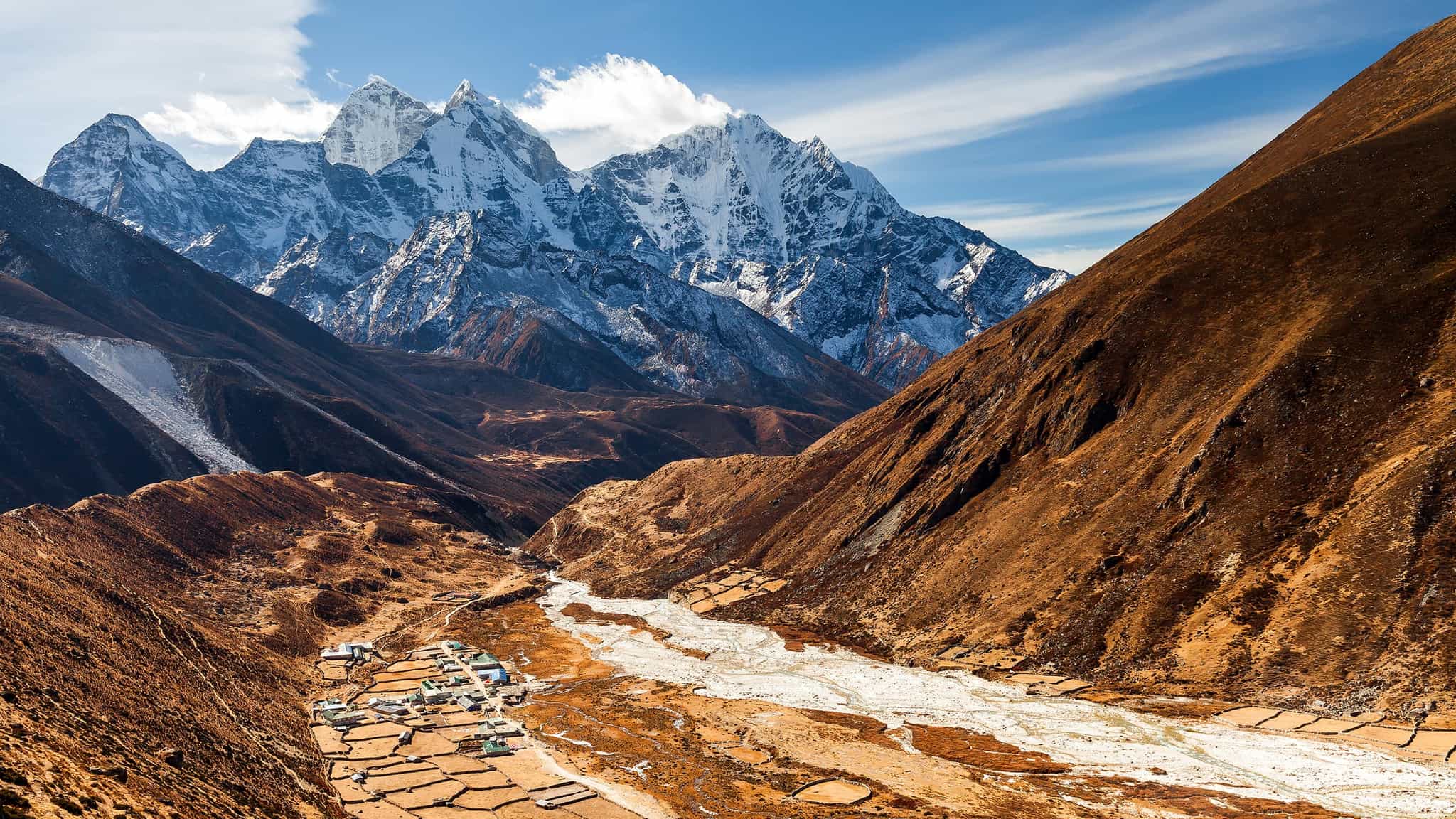
Hike undulating trails, cross suspension bridges, navigate glaciers and dodge yaks as you trek through mountaineering history
Drown in the dramatic mountain views of Nuptse, Lhotse, Ama Dablam and Mount Everest - the world's tallest mountain
Ascend from Everest Base Camp to Kala Patthar at 5550m for views of Everest that only a select few will ever see
Unsure which Everest region trek is for you? Read our handy guide, or check out the alternatives – Everest and Gokyo Lakes Circuit and Everest Panorama Trek
Key Information
Day 1
Arrive in Kathmandu
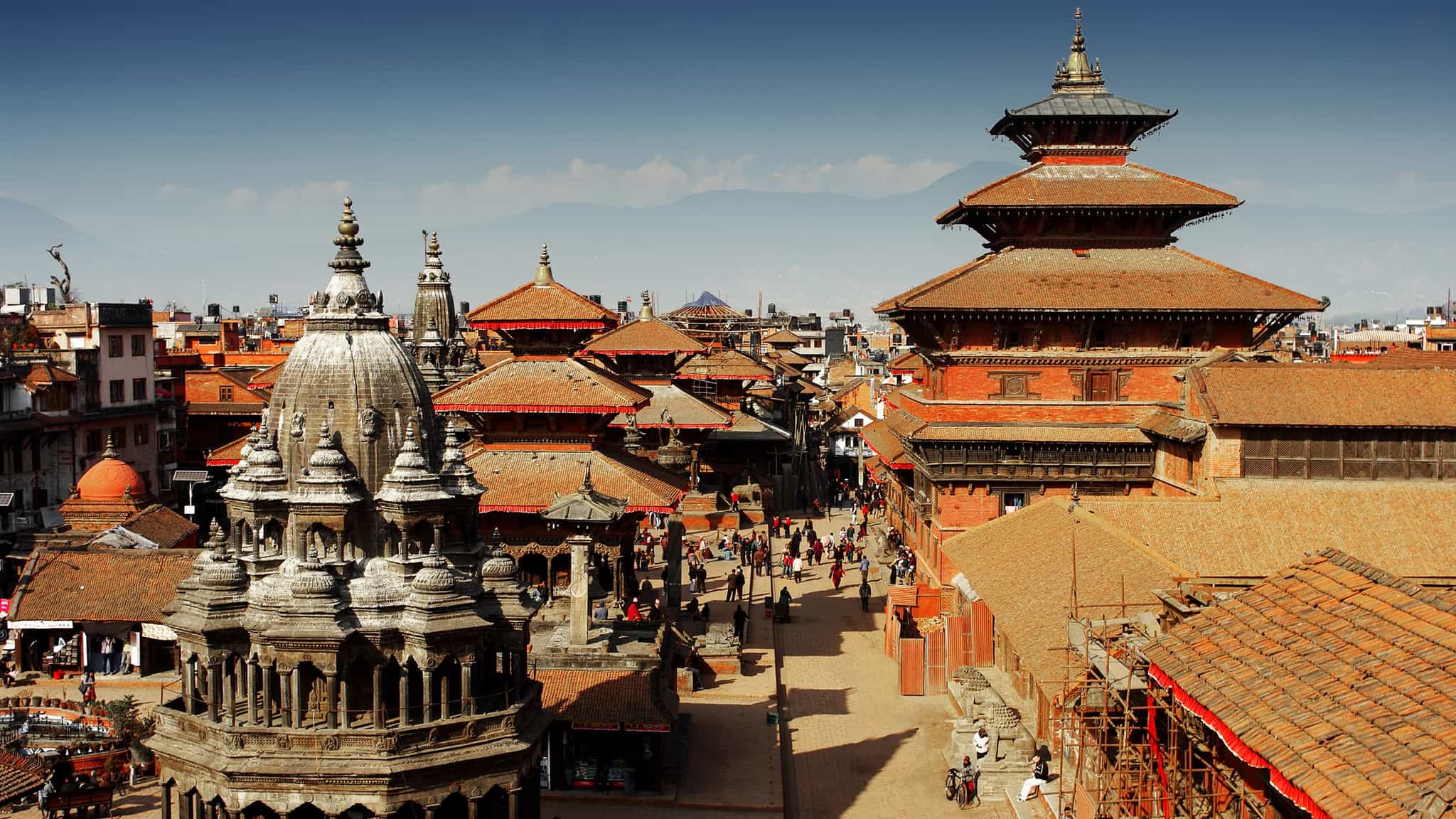
After checking in you'll have a pre-departure meeting with your guides to run through the final plans and arrangements for the trek. You'll finish the day with a group dinner to get to know your team for the next few weeks.
2026 Itinerary Update: From 01 January 2026 onwards, this trip will be one day longer (15 nights/16 days) than is currently displayed on this page. The 2026 and 2027 departure dates listed already reflect the longer duration. For further details, please refer to the FAQ 'What's the itinerary update from 2026 onwards?'.
Day 2
Journey to Manthali
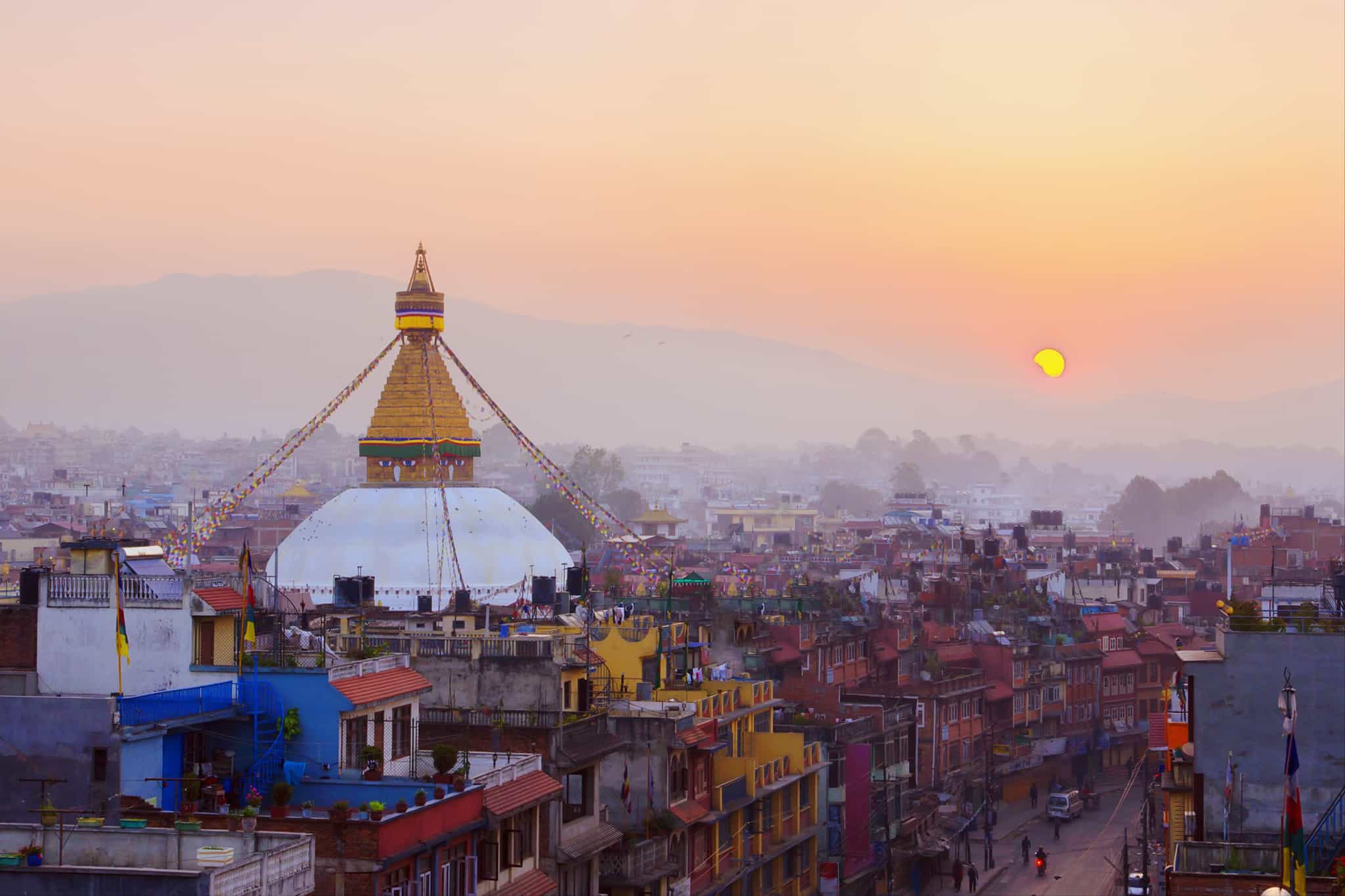
Driving
Head out of the city by bus as you venture to Manthali. This remote region is where most Lukla flights now depart from (although if you're lucky they sometimes depart from Kathmandu out of the peak season) and you'll spend the night in safari tents near to the small airport so you're ready to jump on the first flight in the morning.
Day 3
Trek to Phakding
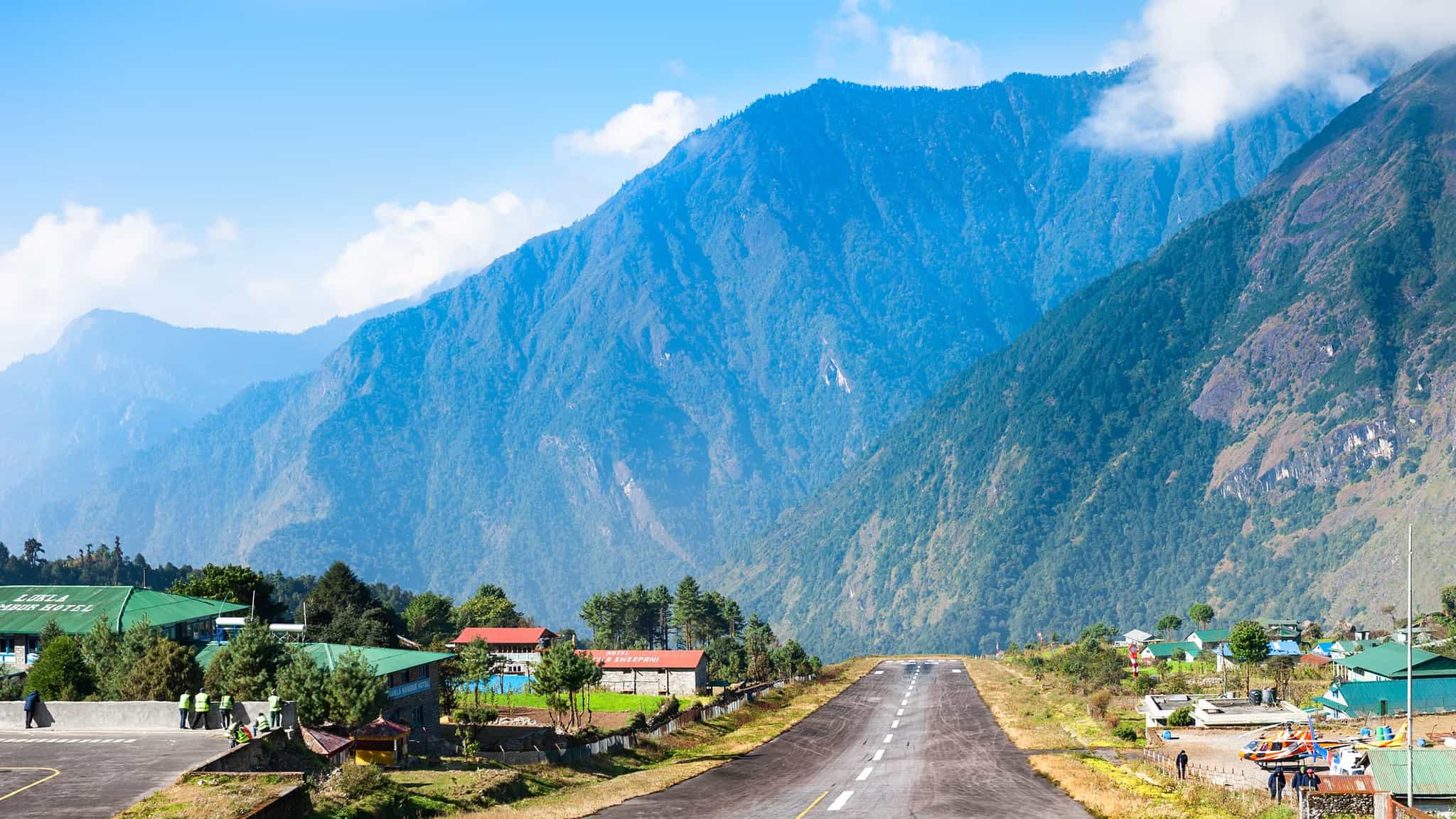
Hiking
Today starts with a short flight to Lukla Airport in the Everest region. After meeting the other crew members you'll start your trek, passing through the prosperous village of Lukla before reaching Phakding on the Dudh Kosi River. You'll spend the night in the village and should have time to visit some of the nearby monasteries.
Occasionally Lukla flights can be delayed or cancelled - please see the FAQs for further information.
Day 4
Namche
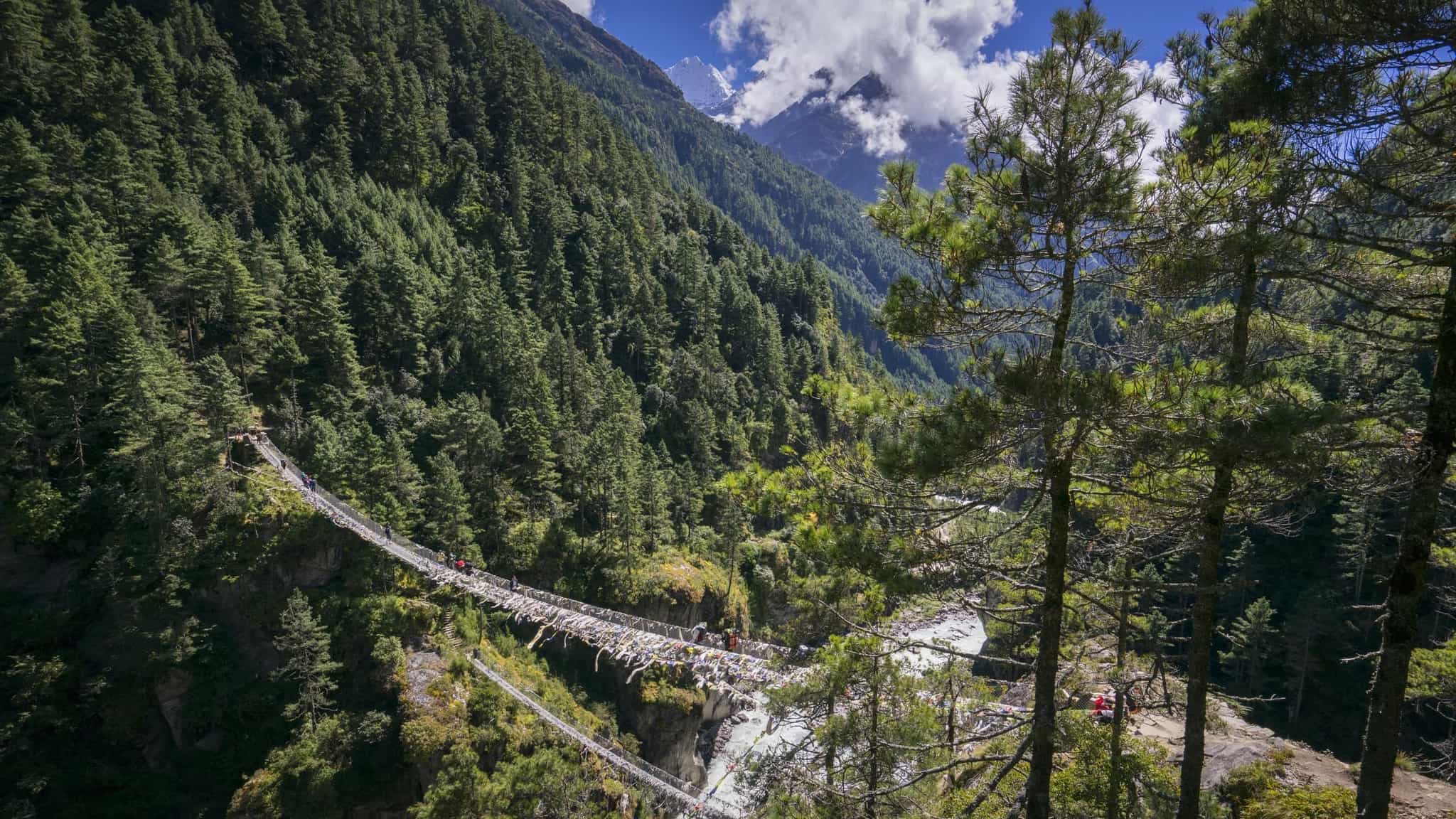
Hiking
Start the day with a walk through beautiful pine forests and along the track to the Dudh Koshi River. One of the (many) bridges is the famous Hillary Suspension Bridge with a particularly epic viewpoint of the gleaming Mount Thamserku (6618 m). From here you'll continue through the village of Jorsale before a challenging uphill climb to Namche Bazaar, where you'll get your first glimpse of Everest.
Day 5
Acclimatise and explore Namche (3440m)
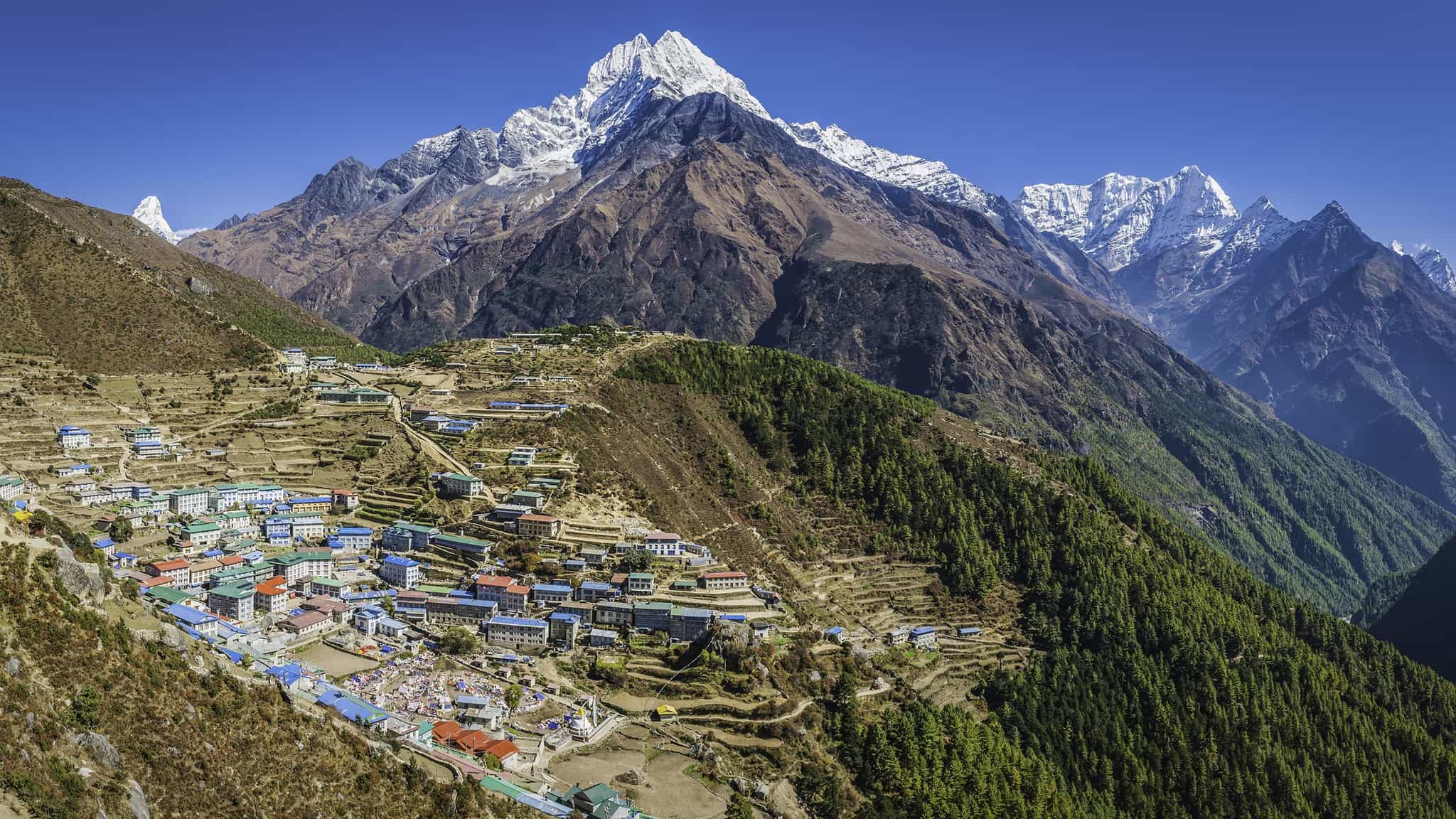
Today will be a rest day in order to acclimatise to the altitude, but rest assured, there’ll be no time to get bored! Instead, there’s the opportunity to hike to a nearby viewpoint and enjoy mammoth vistas of Mount Everest, Ama Dablam, Thamserku, Lhotse...we could go on. On the way back, you’ll walk around the Khumjung valley and have the chance to visit the Hillary School and Khunde Hospital, before heading back for the night.
Day 6
Namche to Tengboche
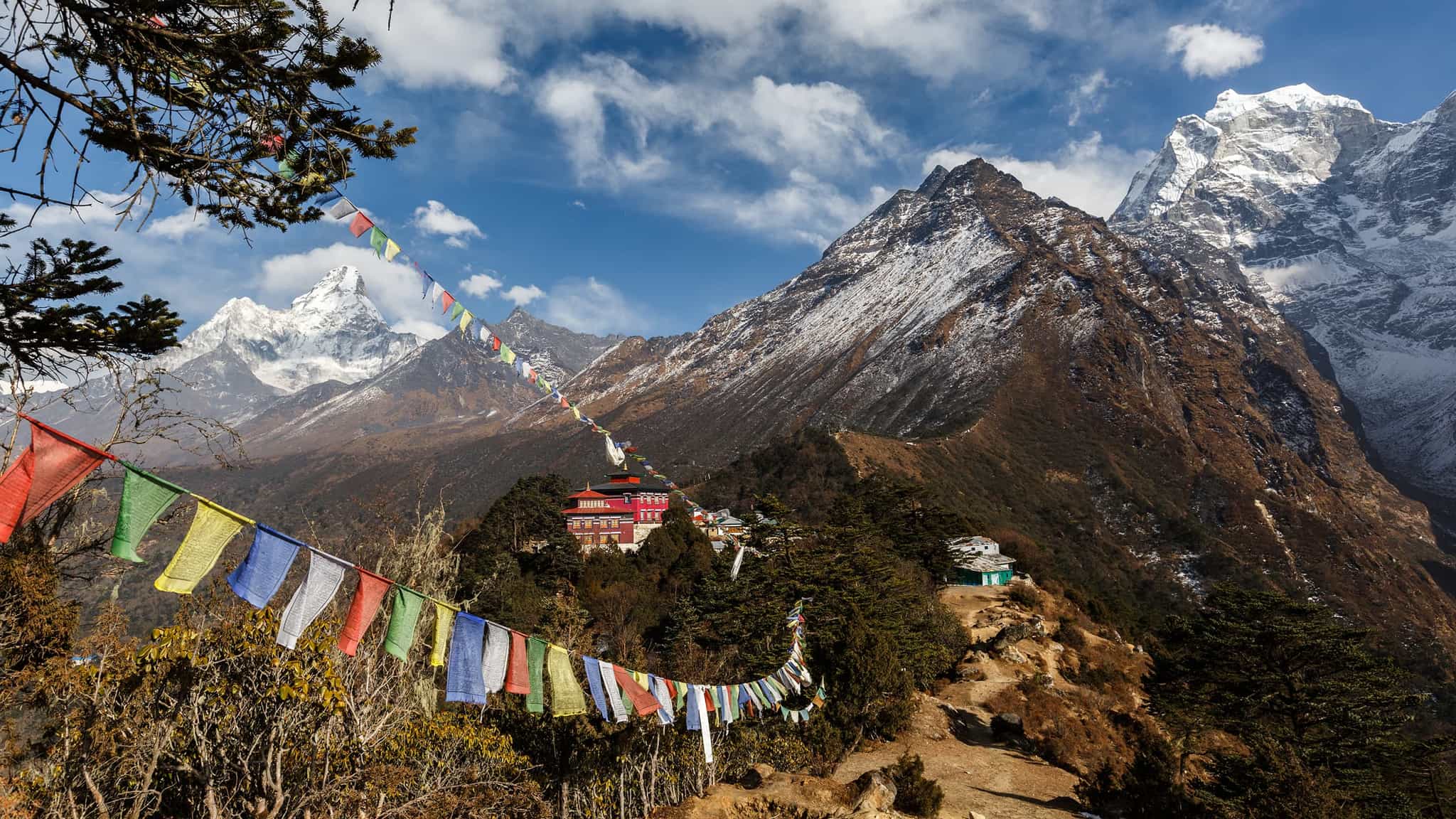
Hiking
Things get challenging as the trail forks northeast along a tributary valley and you approach the holy ground of Tengboche (3860m). There you’ll be met by a monastery, yak pasture and the world’s highest sacred institution combined! Team this with more epic views of Nuptse, Lhotse, Ama Dablam and Everest and you'll find it's worth every puff.
Day 7
Tengboche to Dingboche
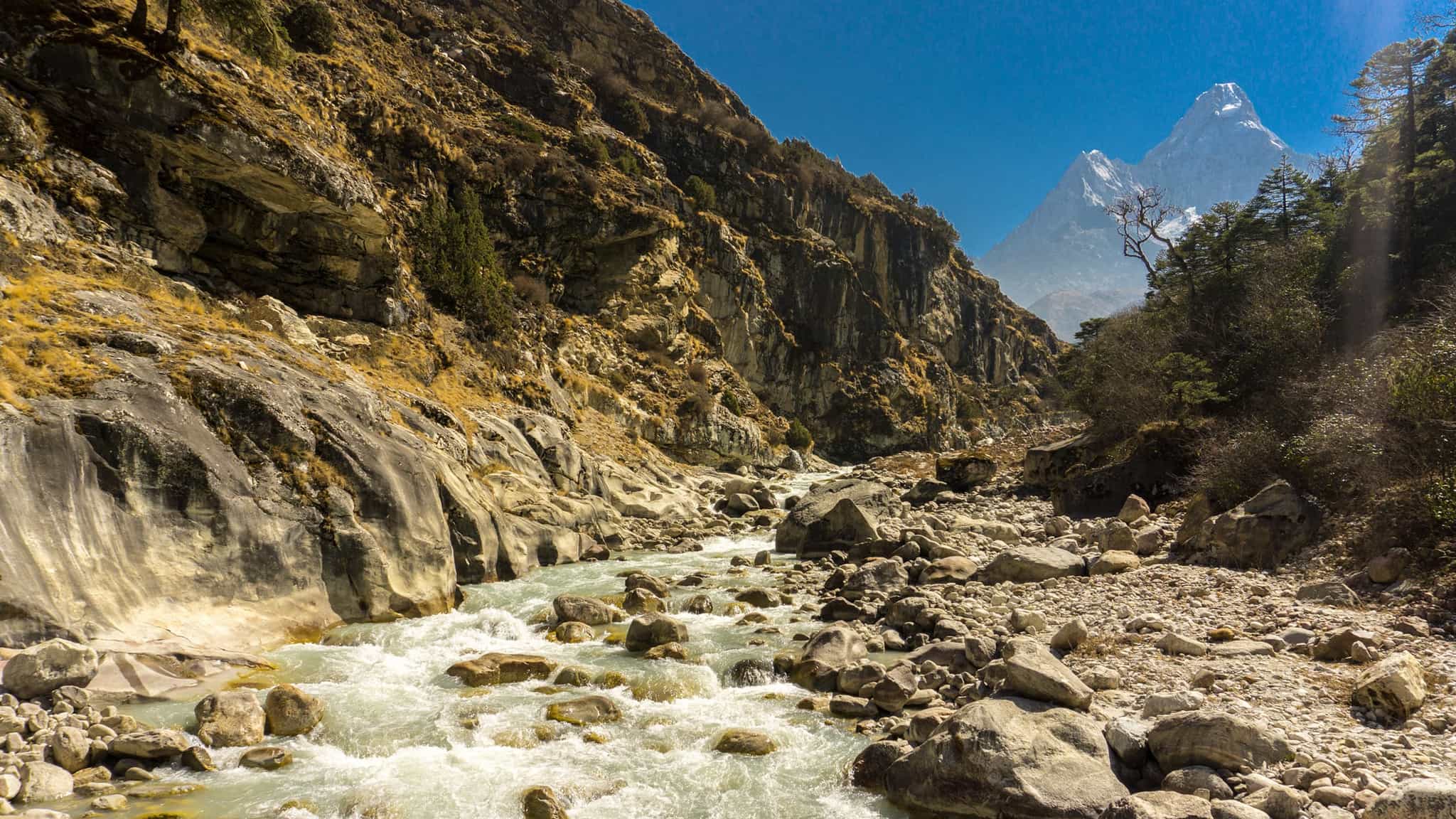
Hiking
Trek past the Gompa holding the famous Yeti scalp and pass summer yak pastures on the way to Dingboche, where you'll stay for the night. Most of the trekking in this area is comparatively gentle, although taking it easy is recommended due to the high altitude.
Day 8
Explore and acclimatise at Dingboche

Today you 'll have your second acclimatisation day at Dingboche (4410m), which is vital considering the high altitudes you’re now reaching. Fear not, you can get still involved in some optional hikes to the nearby Nagajun Hill or Chukung Village which both boast panoramic views of Ama Dablam and Makalu.
Day 9
Dingboche to Lobuche

Hiking
Climb at a leisurely pace and cross ice covered torrents until you reach Lobuche (4910m). Here, you’ll be met with stone houses that sit amongst the frozen wilderness. Only one more night until your goal.
Day 10
Everest Base Camp
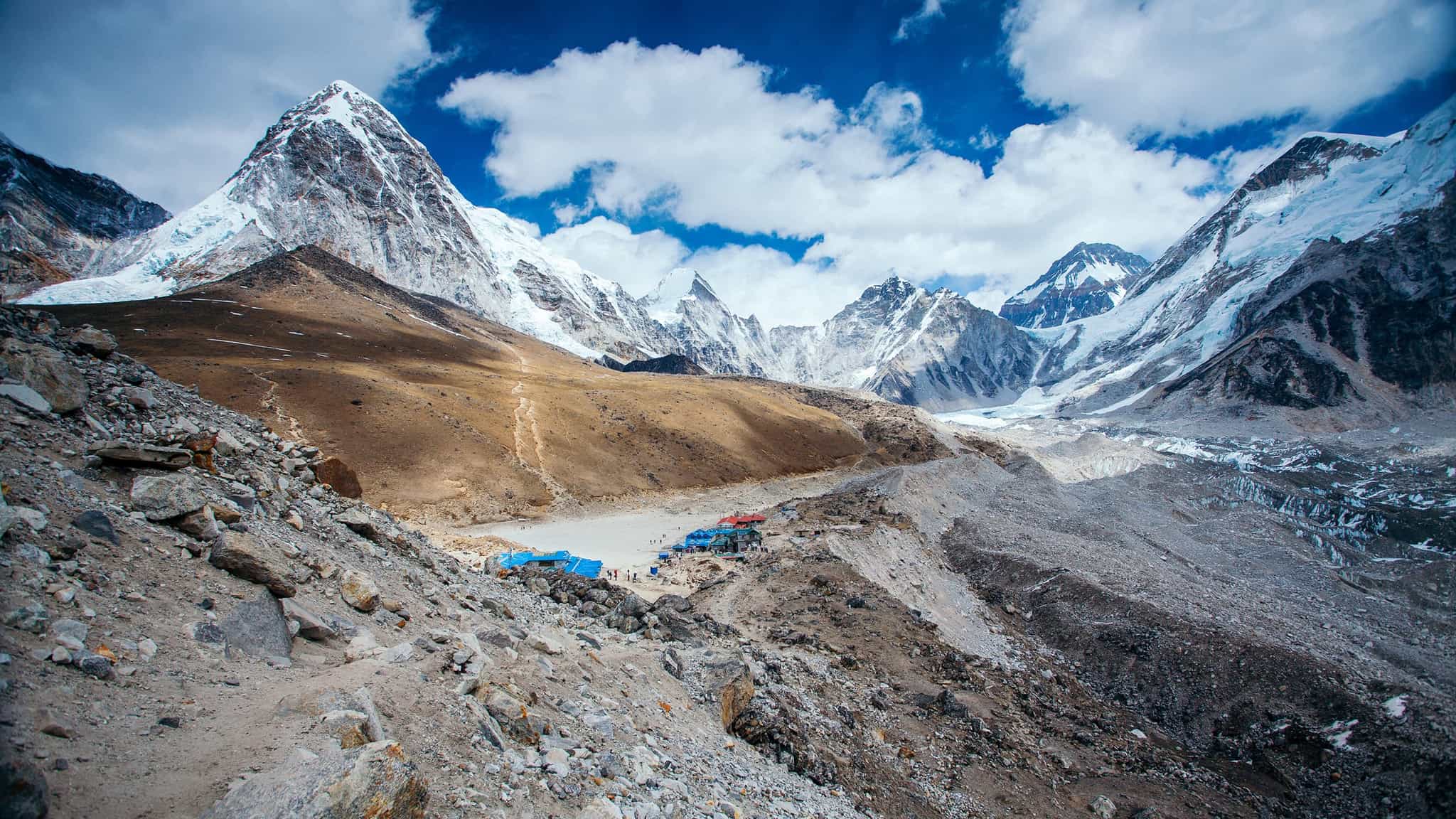
Hiking
Ascend to Everest Base Camp (5380m). Congratulations, you're in the company of legends. Take some time to reflect and enjoy it. Many a new profile picture has been taken here! Once you’ve taken in the views and given yourself a massive high-five, you'll continue back to Gorak Shep (5364m) for the night before beginning the descent tomorrow.
Day 11
Pangboche via Kala Patthar
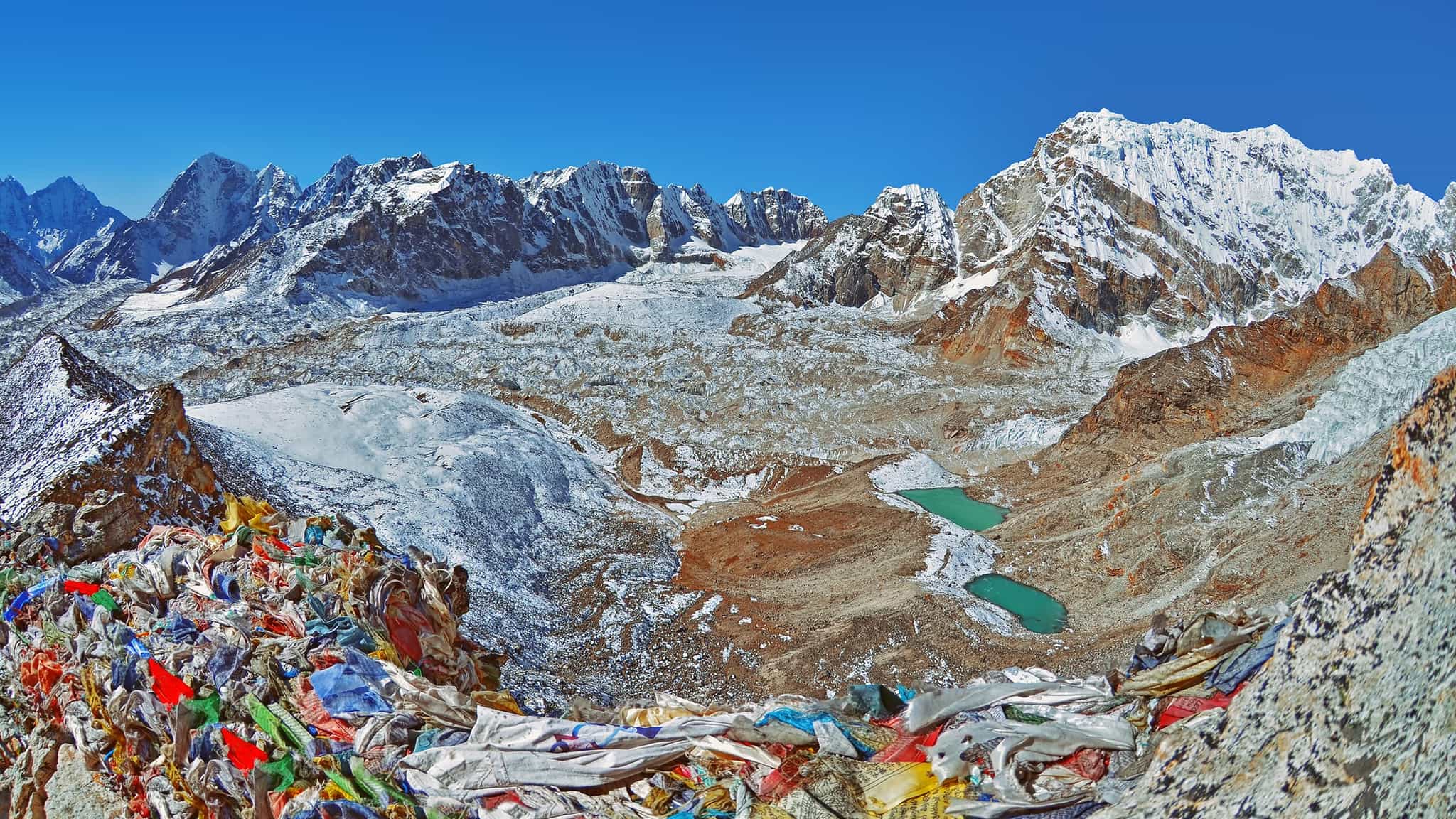
Hiking
The best way to see Everest (and its surrounding peaks) is as the sun comes up so be prepared for an early start. You'll ascend to Kala Patthar (5550m), the highest point of the trip, with awesome views of Everest before heading down to Pangboche for the night.
Day 12
Pangboche to Namche
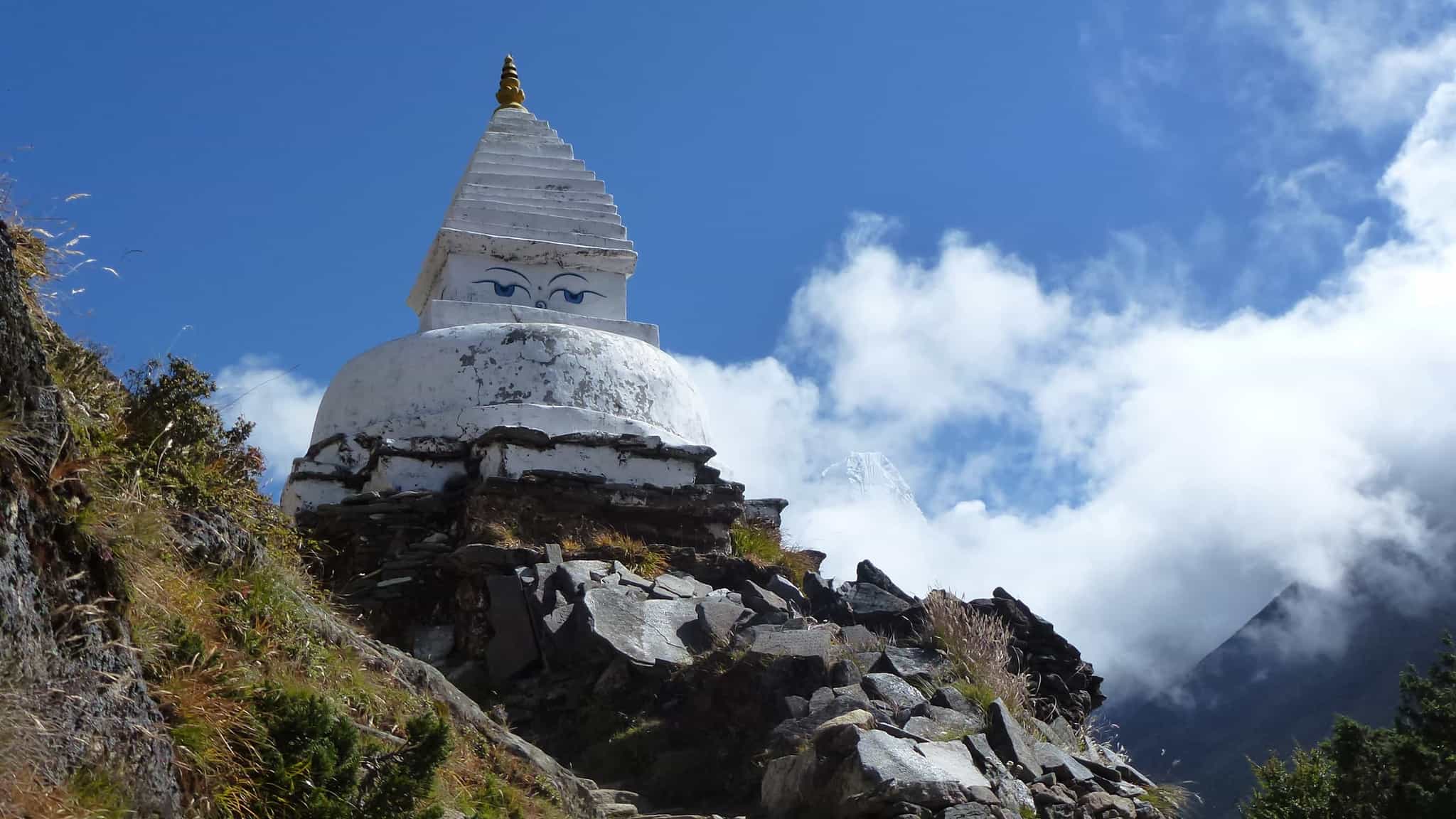
Hiking
Descend down to Phungi Thanga and then continue on to Namche, where you'll stay for a night of celebrations.
Day 13
Lukla
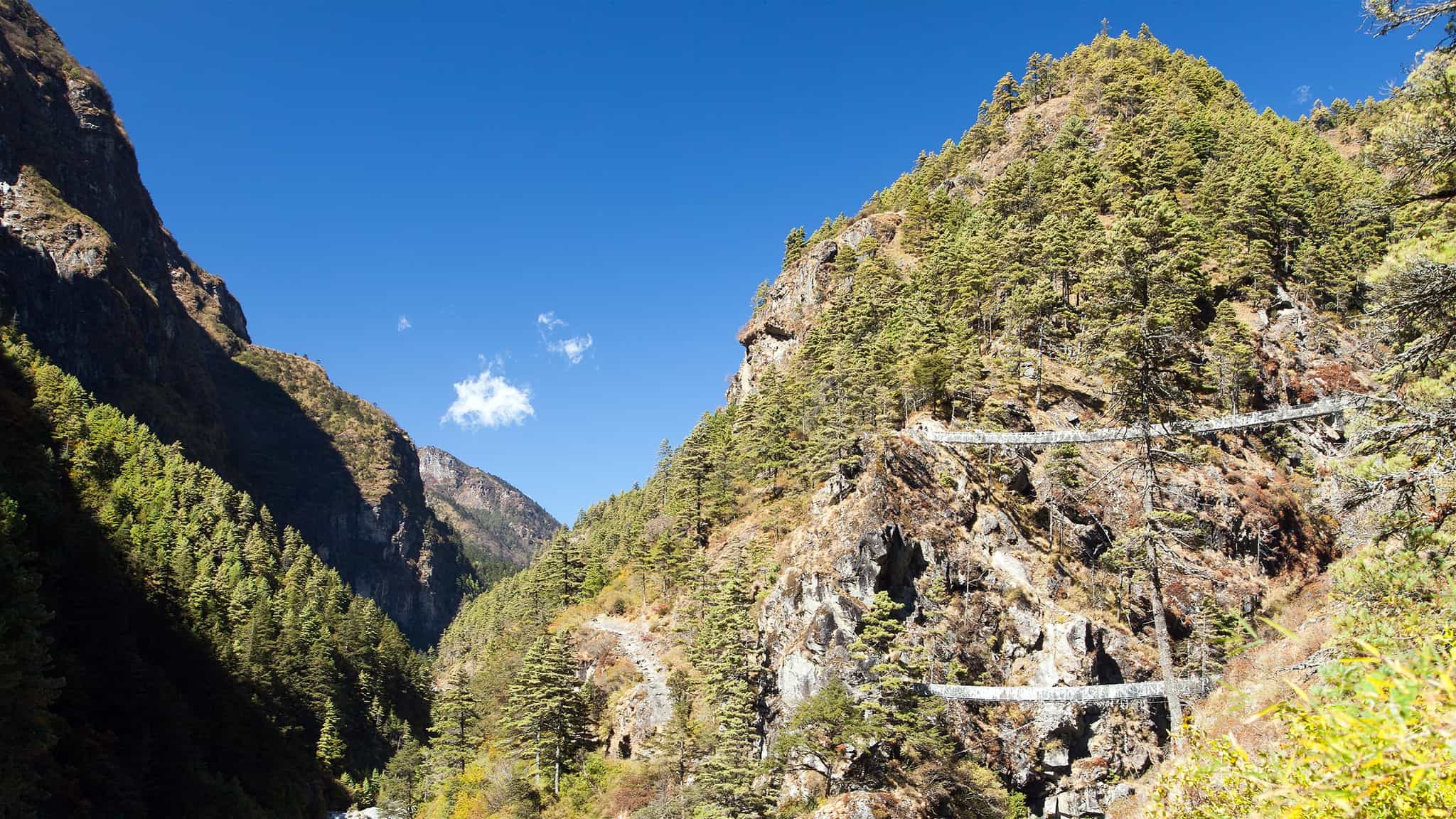
Hiking
Set off for the final descent into Lukla (2860m). On the way, you'll trek through a forest of rhododendrons and pine until you reach a Sherpa village. Here, you’ll have the opportunity to say your final goodbyes to the local team before moving on to Lukla.
Day 14
Back to Kathmandu
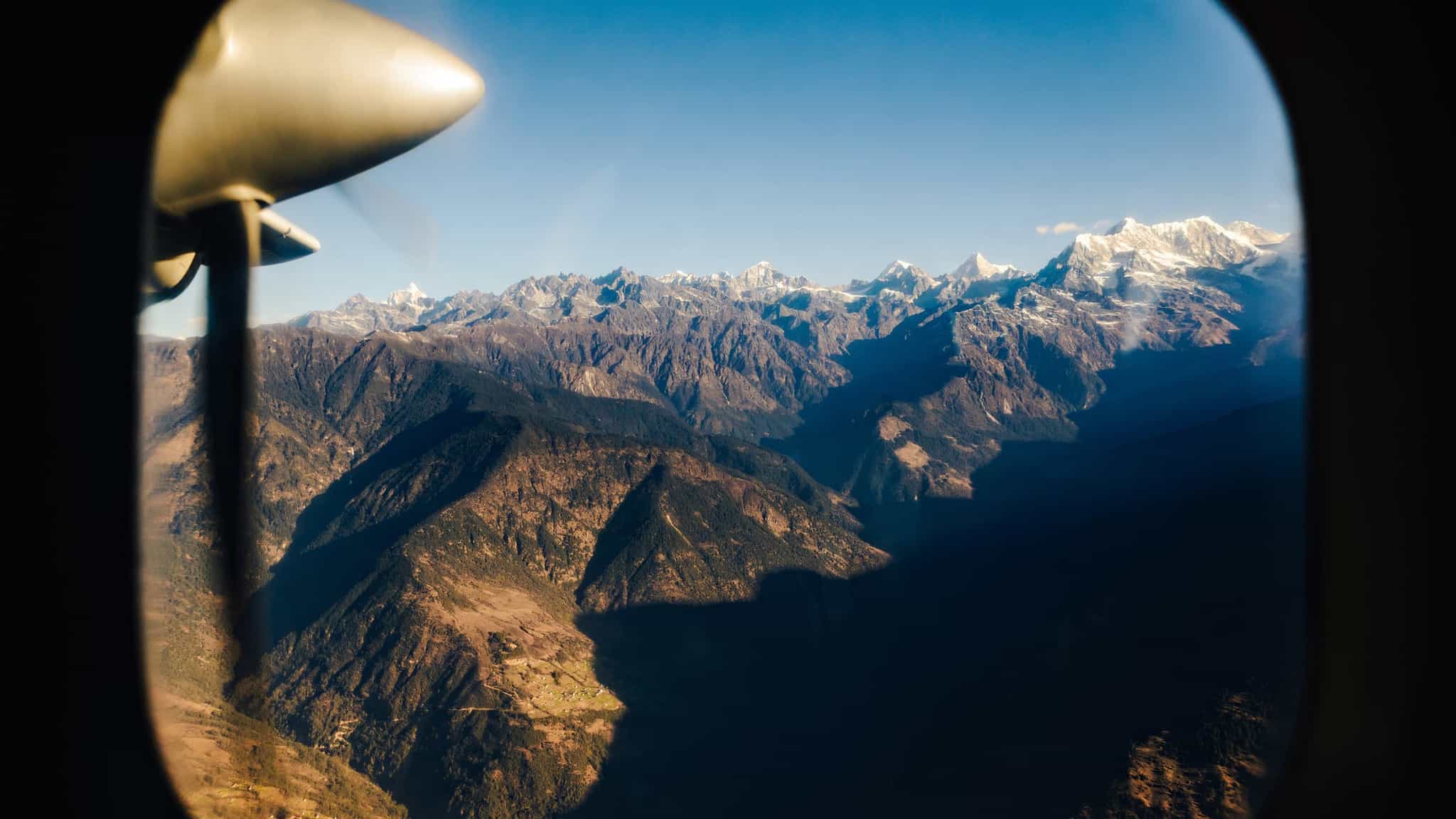
Driving
Fly back to Ramechhap (Manthali) after your incredible mountain journey. You'll drive back to Kathmandu in time for some well-earned beers and a celebration dinner.
Day 15
Last day in Kathmandu
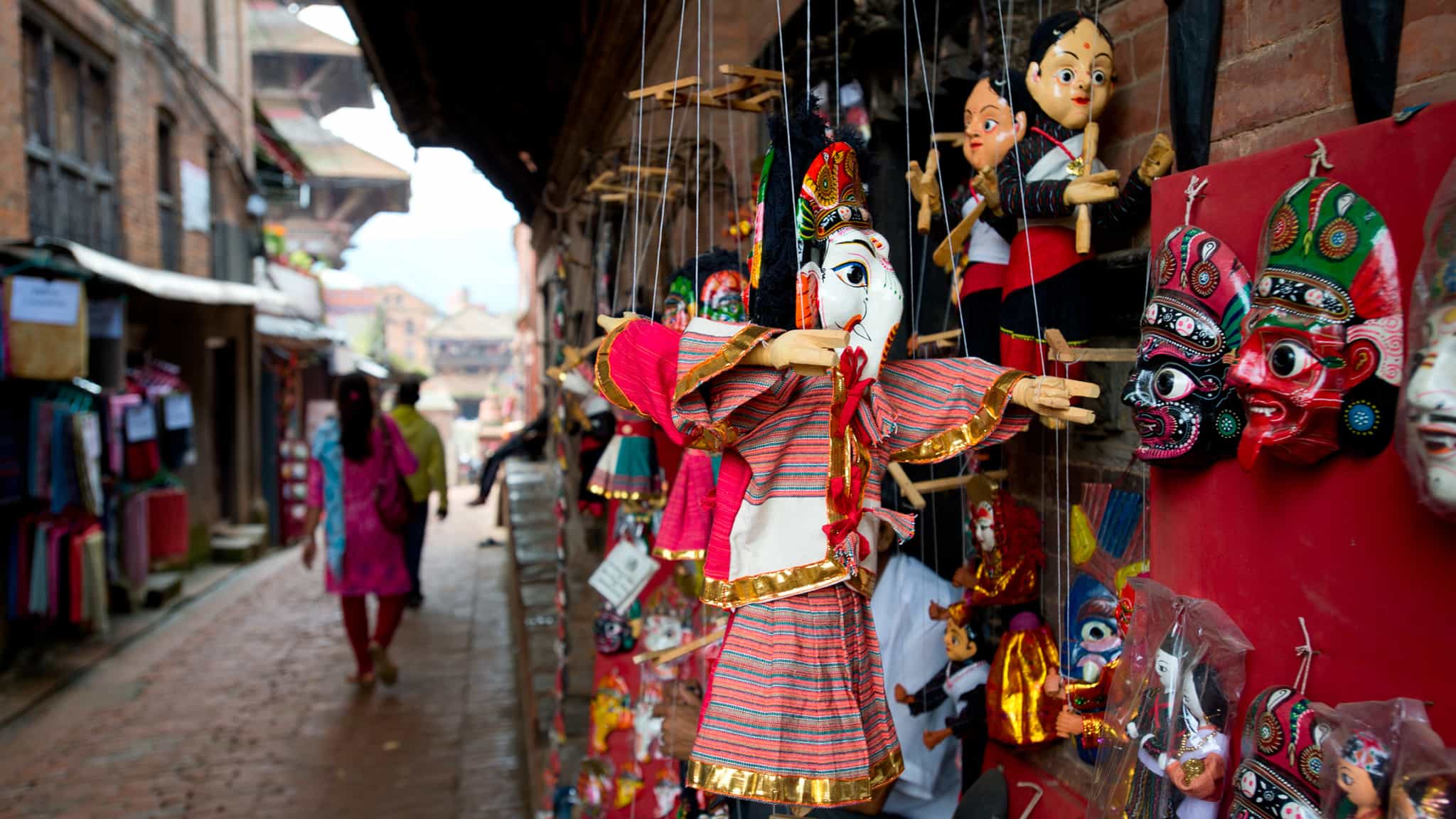
Enjoy a well-earned lie in and breakfast at your hotel, then spend your last day exploring the city before heading back to the airport, and reality.
The Area
Logistics
Starts
Kathmandu Airport (KTM)
Any time on Day 1
Ends
Kathmandu Airport (KTM)
Any time on Day 15 (2026 onwards: anytime on Day 16)
Transfers
Airport arrival and departure transfers are included no matter when you arrive and depart (even if booking extra nights before or after the trip), provided you have completed your passenger information form and have supplied your flight details in advance.
2026 Duration Change: When booking travel arrangements, please be aware that this trip will be one day longer (15 nights/16 days) from 2026 onwards. The 2026 and 2027 departure dates listed already reflect the longer duration; please see FAQs for details.
Travel options
There are regular flights to Kathmandu from major airports in the UK and Europe.
Day 1
Breakfast
Lunch
Dinner
Day 2
Breakfast
Lunch
Dinner
Day 3 – Day 13
Breakfast
Lunch
Dinner
Day 14
Breakfast
Lunch
Dinner
Day 15
Breakfast
Lunch
Dinner
What is the food like?
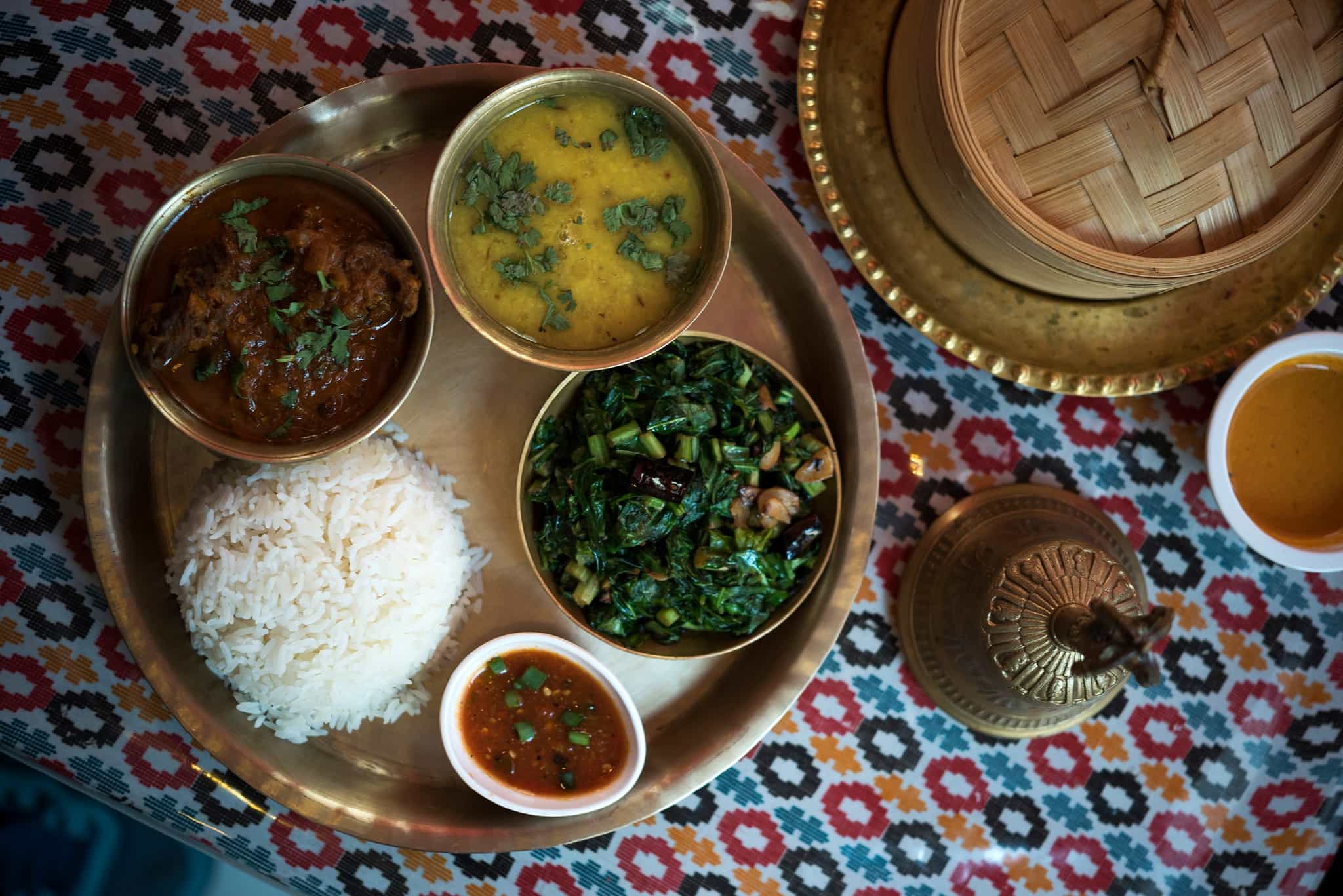
Breakfast is usually either hot porridge, muesli or Tibetan bread served with an omelette or boiled eggs. The menus in the teahouses are very similar at every stop and there will usually be a choice of traditional Nepalese dhal bhat (a mixed plate of lentils, rice, vegetables and pickles - delicious and healthy), Nepalese dumplings (momos), mixed noodles, pasta and even pizza. Although meat is available at some teahouses, we suggest you ask your guide for advice about consumption as it tends to depend on how far it has travelled as to whether it is a safe option.
Dairy-free, vegan or vegetarian diets can be catered for while trekking although meals may get a bit repetitive - dhal bhat will likely be your go-to staple. Gluten-free/coeliac diets are tricky to cater for on teahouse treks (beware that powdered soups and seasonings used often contain gluten, and cooking oil is commonly reused and may cause cross-contamination). Please explain your dietary requirements to your guide so that they can assist when ordering, and bringing along some extra food/snacks is advisable.
What is the accommodation like?
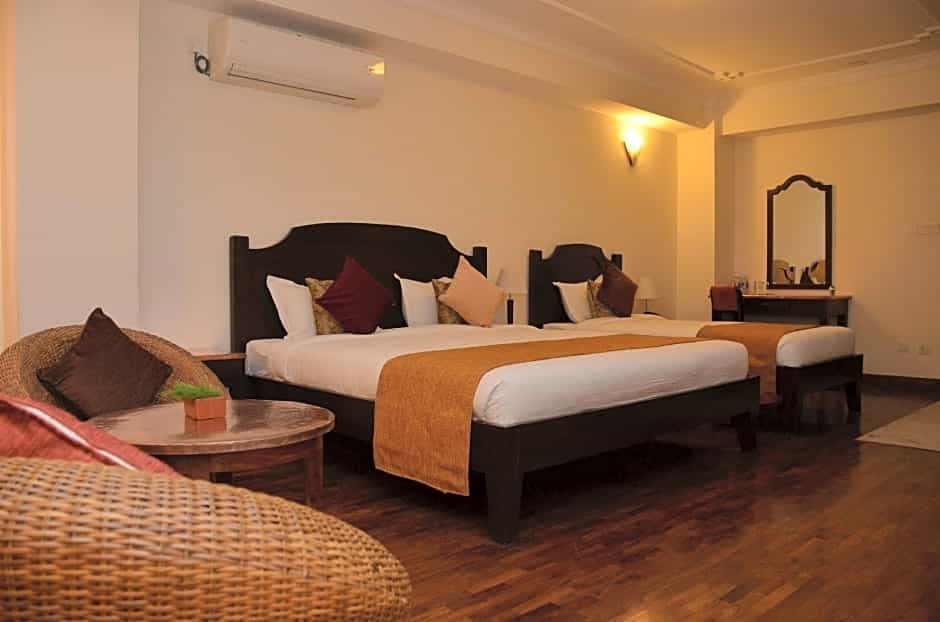
Kathmandu
You’ll stay in a centrally located tourist hotel in the heart of Thamel, close to the main shopping area and heritage sites.
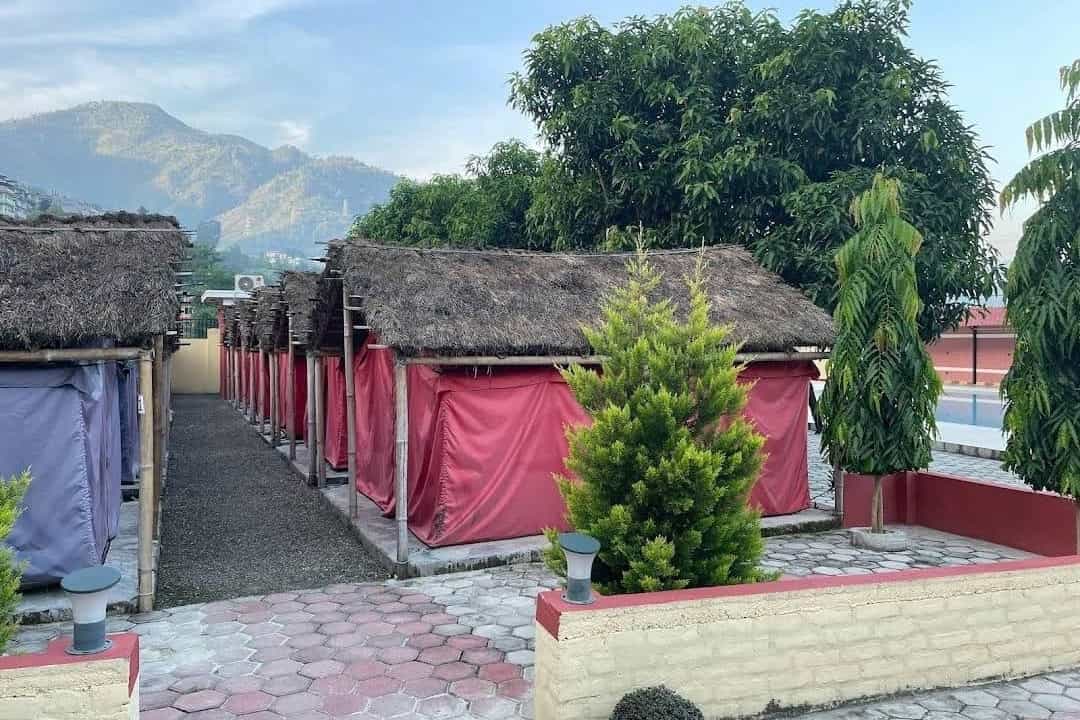
Manthali
For your night in Manthali, you will stay in safari-style tents at the Freedom Resort Fixed Tent Camp. The permanent tents are comfortably set with wooden floors and you will share on a twin-basis with shared bathrooms. There is a swimming pool, restaurant and bar on site.
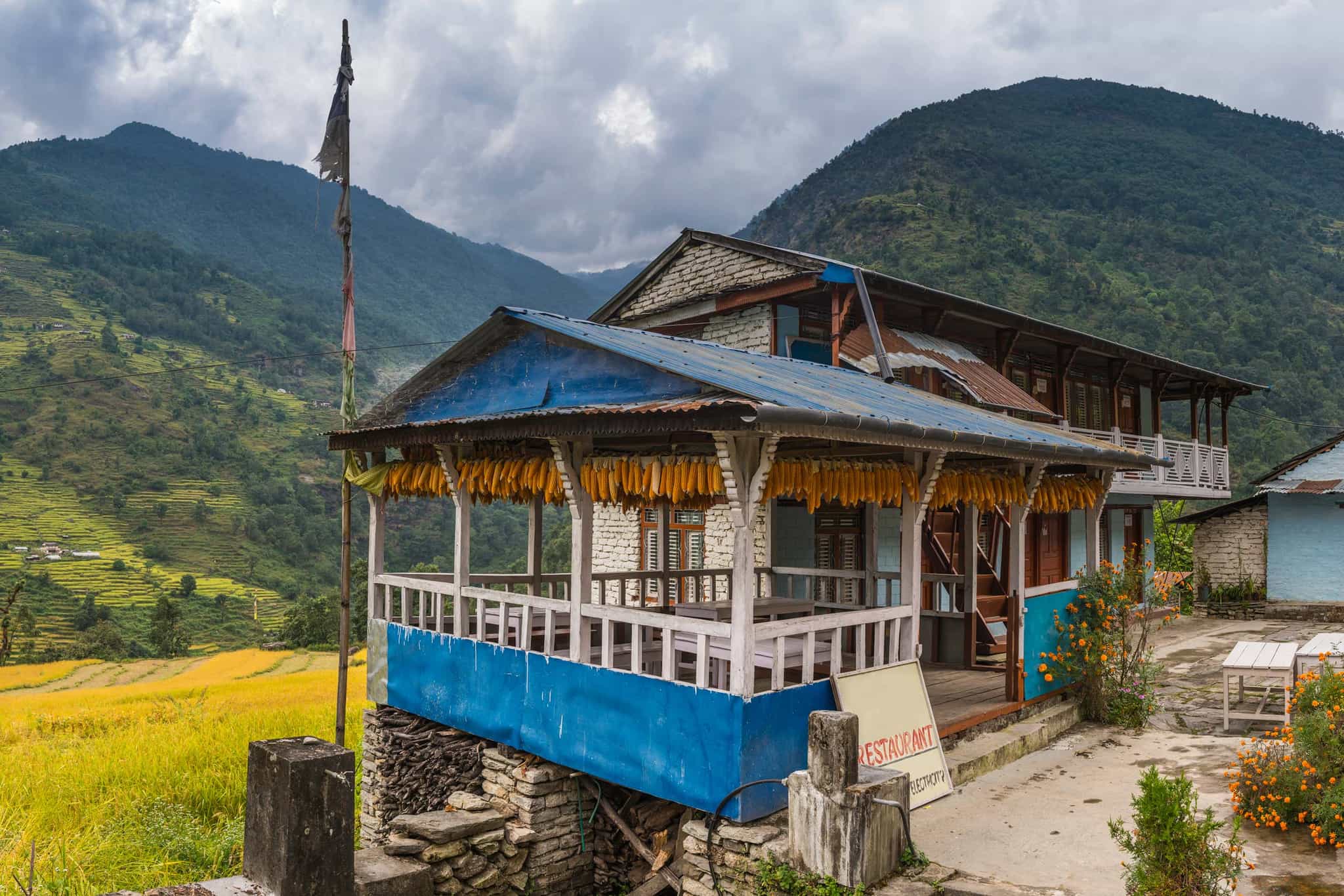
On the trek
Generally, most adventures to Nepal are in remote areas where the accommodation will be basic. On the trek you will stay in 'teahouses' – mountain lodges that tend to have a communal dining area and basic toilets.
The rooms are sorted by gender – however, if there is an odd number in the group they may occasionally be mixed. There’s no heating, so you'll need your warm sleeping bag. WiFi and hot showers are often available at a small cost. You can usually charge your phone up, again, you guessed it, for a cost. So remember to take an adapter.
Upgrades
For solo travellers looking for their own space, an optional private room can be booked for the two nights in Kathmandu only, subject to availability. This option is not available in the teahouses. Please request this at the time of booking: see Optional Extras below for prices.
This trip has been rated as Challenging
Much of the trek is within the capabilities of people with a good fitness who are keen trekkers. Still, it is important to note that trekking at altitudes above 3000m is more demanding on the body than walking at low elevations. Some training beforehand will help and we advise doing at least one weekend of back-to-back days walking. The guide will set the pace and as with all altitude treks, the theme is ‘slowly slowly’ to help you adjust to the altitude.
What will I need to carry?
This trip includes one porter for every two trekkers. They will carry up to 20-25kg of kit in total, so your overnight bags and spare clothes will be transported for you (maximum 12kg per person). You will only need to carry a daypack with essentials in – extra layers, snacks, water, suncream, camera etc.
There are three different seasons for trekking in Nepal.
Winter (Dec-Feb): despite being seen as ‘off-season’ this is often the best time to trek in Nepal. The nights can be very cold (down to –20°C), but the trails are quieter and the mountain views are often at their best due to the clear sunny skies.
Pre-monsoon/spring (March-May): temperatures rise significantly in spring and flowers are in full bloom in the lower lands. Although it can still drop below freezing at night, the daytime temperatures tend to sit between 10-15°C.
Post-monsoon/autumn (Sept-Nov): this is the most popular time to trek in Nepal with sunny and mild days generally. It can get cold and windy at higher altitudes; however, skies are usually clear.
Of course, mountain weather is notoriously hard to predict and snow can be expected at any time, so come prepared.
Trek to EBC + Kala Patthar
What an amazing experience trekking to Kala Patthar and EBC. If you have any thoughts about doing this trek just do it, you will not regret it!
The entire trip was organised absolutely flawlessly and was more than I could ever have asked for, Sanjeet, Tej and Nwang made us feel so at home and truly made the trip. Their expertise, enthusiasm and energy really made the trip as a whole. A special thanks to the supporting staff - Aayush, Santosh, Roshan and Suman for doing the hard work and making sure our bags were always delivered on time and in one piece!
Dhanyaväd!
Thank you to the best guides for a beautiful adventure!
I completed the Everest Base Camp trek in early May. It was a beautiful adventure, and we had the best guides (Sanjeet, Tej, Nwang), who truly went above and beyond — supporting us, sharing advice on handling the trek, and immersing us in Nepali culture. The landscapes and the guides were the best part of the trip! Thank you ❤️
However, I can’t recommend Much Better Adventures to the non-UK crowd. I understand it’s a chicken-and-egg problem, but I would strongly suggest you stop advertising outside the UK market — non-UK travelers will inevitably feel isolated when the majority of trip is coming from one place whereas you speak English non-fluently, and don’t understand most of their cultural references. Since team dynamics on such trips are hugely important, I’d say: if you’re not from the UK, look elsewhere. I will not return for another trip with MBA.
Additionally, the trek is extremely crowded (expectedly - it’s a bucket list for lots of people as it was for me), but such crowds are not pleasant. I’m sure there are other treks just as beautiful but far less crowded.
Once in a lifetime experience
The trek to EBC with Much Better Adventures was absolutely incredible. Our Lead Guide, Kush, and two assistant guides took great care of our group. They had our wellbeing at heart, and filled the evenings with interesting stories and card games. The trek felt well organised and well thought through. I would definitely book another trip since this one was so good!
Everest Base Camp 2025 May
The Trek was well organised and communicated from day one, kush, the guides and support team were spot on. Safety was paramount and taken seriously. We had a great group, which always helps. Tea houses were good, and it was nice to see support going to lesser well off establishments.
No complaints, very good and will see you again x
Jam Jam
An amazing experience with extraordinary people.
Outstanding trip outstanding team
What can I say - our trip to Everest Base camp was outstanding. And made all the better for having simply the best guides and porters on the hill. Nothing was a problem for our guides Sanjeet, Tej and Neang - they paced the group amazing and there knowledge of local traditions, places and culture made for a fantastic trip. All of our group were safely looked after and made it to base camp without a hitch. Our Supporting staff: Suman, Roshan, Santosh and Aayush made sure our bag were at our tea houses safe and dry each day before we were. 5 star service from a 5 star team.
Amazing trip
Our guides especially lead guide Kush were amazing and very helpful with everything. Will 100% be using MBA again.
Excellent trip + excellent guide!
A great trip that was well organised by both MBA and Freedom Adventures. Our guide, Rinji, was excellent and great company at all times. It was clear we were in very capable hands, with Rinji's expertise extremely helpful and reassuring. I'd recommend Rinji to any travellers hoping to climb up to Base Camp or any other part of the Himalayas. Similarly, our assistant guide, Uttar Rai, was brilliant and will make a superb guide one day.
What an experience!
This was the most beautiful hike I've ever done. Every day we were greeted with breathtaking new views of peaks, valleys and villlages. And the best part - the lead guide Kush and assistant guides Tashi and Nabin kept us informed, entertained and humored all along. Besides being attentive to each one of us and our needs during the hike, they meticulously planned each day taking care of the whole group. The support staff did a phenomenal job with our big heavy bags, always making sure the bags were already at our next stop before us. Many thanks to my other hiking group mates as well. You made the whole experience so enjoyable.
EBC
Epic views that you have to experience. Our guide and assistants couldn’t have done a better job informing us of mountains what to expect how to make us ready for next day daily stories and information about culture lived it all


Faultless, amazing trip.
Amazing trip! Would definitely recommend this MBA trip it was so well organised and everything was made so easy for us. We had a great group which made it better plus great guides. Our leader was Sanjeet and he was the perfect lead guide. He was so helpful and always took time to explain things and answer any questions. Tej and Nwang were the assistant guides and again they were great. They always made sure we were feeling ok, enjoying ourselves and had a laugh with us. It was a really enjoyable trip helped a lot by our guides. The porters, Aayush, Santosh, Roshan, and Suman were also fantastic. We never had a problem with any of our bags. They were always at our hotel for the night before we got there so when we got there we could have our bags straight away plus they spoke to us when we saw them on the trail!. From start to the finish the trip was organised perfectly, we never had a problem. I couldn’t recommend these guys enough. A trip to always remember. Thank you.



EBC May 2025
Amazing trip, the weather was exceptional, the views were even better. Our guides were fantastic and set a pace for everyone in the group to complete the trip and see the majestic Everest Base Camp. Would highly recommend



Trip of a lifetime
This was my second trek with the MBA. Similarly to the first time, the local guides Sanjeet, Tej and Nwang, as well as the porters, were fantastic, everything was very well organized and my job was just to acclimatize, dress appropriately for the weather conditions, and make sure I conquer every hill and mountain on my way. EBC had long been in my bucket list and thanks to the guides and amazing Nepal, it was everything and more that I imagined - definitely recommend.



Once in a lifetime experience
Nepal is an amazing country and this expedition is wonderful. The information provided beforehand by MBA was pretty useful. It’s the local team (Freedom Adventures) that really shone. Sanjeet, Nwang, Tej, Aayush, Santosh, Roshan and Suman were all amazing in getting us to Base Camp and Kala Patthar safely and with a wonderful injection of fun and personality. The trek is physically demanding, but with the right attitude, kit and precautions most will find it doable. The tea houses were actually much better than expected.


Fantastic experience!
Hiking to EBC was one of the most unforgettable experiences Ive ever had. Around every corner are stunning views the pictures don't do it justice!
Tejshree was our lead guide, she did a fantastic job! She was friendly, informative and supportive throughout the trip. Many of my highlights of the trip involved playing cards with her and the other people in our group in the teahouses in the evening.
Our groups supporters Naramani and Aayush were also incredibly kind and helpful throughout again the trip.

Amazing trip to Nepal and Everest Base Camp
My stepson and I recently completed the Everest Base Camp trek, and I can confidently say it was one of the most incredible experiences of our lives — made even more special by the amazing team who looked after us every step of the way.
From the moment we arrived in Nepal, we felt welcomed, safe, and supported. Our leader, Kushahari Phuyal, was nothing short of exceptional — knowledgeable, calm, and always attentive to the needs of the group. His leadership gave us confidence and made the journey feel seamless, even in the most challenging moments.
A huge thank you to our wonderful assistants, Sebika Rai and Roshan Rai, whose energy, encouragement, and kindness were constant sources of motivation. They were always there with a smile, helping us navigate the trail and making sure we were comfortable.
We were also incredibly grateful for the hard work and dedication of the support staff: Sukra, Pratiman, Prabesh, Sanggam, and Langka — each of them played a vital role in making our trek smooth and enjoyable. Their efforts behind the scenes made a world of difference.
This journey was not just about reaching Base Camp — it was about the people who made it possible. The warmth, professionalism, and care shown by the entire team turned this adventure into a lifelong memory.
If you're considering trekking in Nepal, I wholeheartedly recommend this team. You’ll be in the best hands.
Dhanyabad and much love to the whole crew! 🙏🏔️

A much better adventure
From start to finish, every detail was meticulously taken care of including hot towels at the end of each day’s work walk - what a great touch. Stunning scenery combined with cultural visits, historical talks and challenging terrain made the trip a magical mix up. Throw in a great group of fellow trekkers led by ‘King’ Kush our brilliant lead guide, fabulous assistants Roshan and Sebika( who sprinted to my rescue on a couple of occasions!) and support staff Sukra, Pratiman, Prabesh, Sanggam and Langka - we could not have asked for a better trip. Freedom Adventures so professional for other trips arranged whilst in Nepal. Thank you and keep smiling
Amazing few weeks
Start to finish the trip was excellently organised- all you need to do is walk! Kush was brilliant- very knowledgeable and gave interesting insights on local culture and traditions. Sebika and Roshan were also excellent, very helpful and a very funny. Also the trip wouldn’t be possible without the support staff- thanks a lot. Will be coming back !!!!!

EBC trek April 2025
From start to finish everything was perfect and organised with a fine tooth comb. Kush, Sebika and Roshan were excellent guides (& friends) and made sure our group wanted for nothing. We also couldn’t have done it without the support of our team of porters carrying our big bags. Heroes! The trek itself is breathtaking the whole way. I wouldn’t hesitate to enthusiastically recommend it.



Amazing experience!
Hiking in the Himalayas amongst some of the tallest peaks on the planet was such an incredible adventure.
Tejshree was a fantastic guide and we couldn't have wished for a better leader for the trip. She taught us so much about the mountains and surrounding culture which made the trip much more meaningful. She was always very friendly, supportive and kept it super fun (she knows some great card games for downtime)!
A big shout out to our groups supporters Naramani and Aayush is also needed. They were incredibly kind, friendly and always smiling.
The whole trip was unforgettable and I'm already wanting to go back to the Himalayas on some of the other MBA/Freedom Adventure trips!




Unforgettable Himalayan Trek with Tejshree Basnet and Team
I'm so grateful to our guide, Tejshree Basnet, and porters, Noro and Ayush, who truly made this trip incredibly special and memorable for me.
As breathtaking as it was to see the Himalayan range—Everest and other stunning summits like Ama Dablam that I fell in love with—spending two weeks with the team taught me so much more about Nepali culture, hospitality, kindness, and connection. It gave me a very different perspective on life, as we navigated terrain, changing altitudes, and remote tea houses.
I felt unwell after reaching 4,000 meters, and Tej took incredible care of me, both physically and mentally. It was especially meaningful to be led by a female guide—so knowledgeable, responsible, attentive, caring, kind, and simply fun! Our porters, Noro and Ayush, did far more than carry heavy bags. Working as a great team alongside Tej, they were always attentive and offered help in so many other ways.
The trek was challenging for me due to the altitude—so don’t neglect or underestimate it—but that also made the experience even more memorable, as I learned so much about myself, nature, and the people around me.
Amazing Bucket List Adventure
What an unforgettable experience, absolutely amazing. The scenery is incredible and never failed to blow me away every day. What made it though were our amazing guides and porters. Pujan is a legend! It seems he knows everyone and has an encyclopedic knowledge. Learning about the area and people made the experience so much more rewarding.
Teejshree and Benja were fantastic lead guides, so experienced and knowledgeable, but also looked after us all so well during the days and evenings. I've also got to thank the porters for carrying our extra kit: Tashi, Ramesh, Krishna, Langa and Dickchan.
If you love challenging, multi-day hiking then this has to be up there with the best there is. So well organised, and super flexible when things inevitably don't go exactly to plan.
Best guides ever
The highlight of my hike into EBC was our fantastic guiding team - Kevin, and his support guides Ujjwal and Birdhoj. They were professional, knowledgeable and caring. The support staff helping with airport collection/transfers were also fantastic, and the communication in the lead up from the local team was great. Highly recommend booking with this company.
EBC Trek
Fantastic trip from start to finish. So many great memories made along the way. I would like to thank our lead guide Kevin and his assistants Ujjual and Bir for looking after us all. They attended to all our needs and were so helpful. I would also like to thank our porters for carrying all our extra kit. These guys do a great job and deserve so much respect. I would highly recommend Much Better and Freedom Adventures.
Everest Base Camp is Incredible!
The trek to Everest Base Camp is incredible! If you love multiday hiking/backpacking, this trip is for you. It was very well planned, organized and communicated. The beauty from start to finish was breathtaking. We learned a lot about history and culture along the way. Because of the mental and physical work of this trip, our whole group felt accomplished and proud once we were done. Crossing all the suspension bridges, yaks, pretty flowers, fun group and insanely big mountains were all highlights for me.
Fab Trip
Thank you to our guides and porters the excellent service they provided to our group.
Superb
This trip was fantastic - well-organised and with incredible scenery. The best thing about the trip was all of our excellent guides - Kevin in particular was the best tour guide I have ever had - he was attentive to the needs of his clients and always cheerful. I would love to stay in touch - thank you so much Kevin for an amazing trip!
Everest Base Camp Trek
The trip was absolutely amazing and an unforgettable experience! It is challenging but well worth the effort.
We were guided by a brilliant team in Pujan, Tej, Tashi and Nabin who were all very experienced and extremely helpful throughout - not just on the trail but in the teahouses along the way.
and of course we couldn't have made it without the Porters who helped bring our luggage up the trail. It was really nice to share a meal with them back in Lukla.
In future it would be good to see the cost of the helicopter option updated as it was a bit higher than expected.
Overall the team did a great job!
Fantastic Bucket List Trip
What can I say! This was a fantastic. Trip and something that was well worth the wait! Group size of 8 was perfect, Lead Guide Kevin, Assistants Ujjual and Bir were all fantastic! Along with our 4 porters. Fantastic lead trip from start to finish.
I would highly recommend Much Better Adventures and Freedom Adventures for this trip. 3




Amazing trip!
An amazing trip from start to finish! Everything was so well organised and taken care of. The MBA and Freedom Adventures team were so helpful throughout the booking process with excellent communication and sharing information. All aspects of the trek ran so smoothly - Sunil, Bijaya and Uttar and the whole team in Nepal were so caring, helpful and knowledgable and could not do enough for the whole group.
Itinerary Activities
- 9 days of guided trekking along the Everest Base Camp route, via Kala Patthar
- 2 acclimatisation days (with optional short hikes)
Guides
- Expert, local, English-speaking guides
Accommodation
- 2 nights in a centrally located hotel in Kathmandu
- 1 night glamping in safari-style tents
- 11 nights in traditional teahouses along the trail
Meals
- 2 breakfasts
- A welcome dinner in Kathmandu on Day 1
- A farewell dinner in Kathmandu on Day 14
Internal Flights
- Internal flight from Kathmandu or Manthali to Lukla
- Internal flight from Lukla back to Kathmandu or Manthali
Transfers
- Arrival transfer from Kathmandu Airport at any time
- Departure transfer to Kathmandu Airport at any time
- All other transfers throughout the trip
Porterage
- A porter will carry your overnight luggage on the trek
Permits
- All your trekking permits and fees are covered and sorted
Our trips are hassle-free by design. We include all the activities and equipment, so you can simply rock up with your rucksack and share the adventure with your new pals.
Travel to and from the trip
Our trips do not include flights, trains or other travel to the start point and back from the end point.
Meals
We do not include meals on the trekking part of this trip, as from experience we know that altitude and physical exercise can mean appetites vary hugely.
The cost of food rises as you ascend as it is all carried in by porters and yaks and as you get higher up, very little food can be grown. How much you spend per day will vary according to your choice of meal but generally, people spend between $25-$35 per person, per day on meals and hot drinks. Below is an approximate breakdown of some items:
- Dal baht: $4 to $7
- Chow mein: $2 to $4
- Eggs: $2 to $4
- Toast: $1.50 to $3
- Tea/hot chocolate: $1 to $3
- Chocolate bars: $2 to $4
Teahouses will provide cold water free of charge; however, it needs to be treated to enable you to drink it. Please read the FAQ below regarding our advice here.
Miscellaneous costs
Other extra costs at the teahouses to be considered are:
- Shower: $2-$4
- WiFi: $2-5
- Electricity: $2-5
See the below FAQ 'What’s Plan B in case of Lukla flight cancellations?' also.
Tips
It is customary in Nepal to tip guides and porters. Although it may not be customary to you, it is of considerable significance to the people who will take care of you during your travels. You can give any tips to your lead guide at the end of your trip. This will then be shared amongst the whole team. For full transparency, the lead guide will distribute the tips to the guides and porters in your presence. It is customary for the guides to receive a higher share than the porters as they are more highly qualified.
A good rule of thumb is around $140pp as a tip, although the amount you give is entirely your choice.
If you would like to give an additional tip to a member of the team who has supported you personally, please do so directly and discretely.
Travel insurance
Travel insurance is compulsory for all of our adventures and you are required to provide your policy information before departing. Your insurance should include adequate protection for overseas medical treatment, evacuation/repatriation, your baggage and equipment and the specific activities involved on your adventure. We also strongly recommend it includes cancellation and curtailment insurance, should you be unable to join your trip for specific reasons such as illness. Our recommended travel insurance provider is Campbell Irvine, as their insurance offers all of the above.
Owing to the nature of this trip, it is essential that your personal travel insurance policy provides cover to the maximum altitude visited on this trip (5550m) as well as for emergency medical evacuation by helicopter.
Visas
Visa requirements often change, and you are responsible for obtaining any required visas for this trip. Please check with your nearest embassy or consulate for up-to-date advice.
Personal Expenses
You know your own spending habits best, so please budget an appropriate amount for things like optional meals and drinks, shopping, optional activities, and laundry.
What do I need to bring?
- Day pack with rain cover (30 litre +)
- Rucksack or duffle bag (for the porters to carry overnight kit)
Clothes
- Waterproof jacket
- Lightweight down jacket
- Waterproof trousers
- Lightweight trekking trousers
- Hiking shorts (if trekking in the summer)
- Thermals (top and bottom, merino ideal)
- 2/3 trekking t-shirts/shirts
- Fleece or warm mid-layer
- Waterproof thick gloves
- Glove liners
- Hiking socks and lighter walking socks
- Wool hat
- Sun hat
- Spare underwear
- Buff or similar
Shoes
- Worn in waterproof hiking boots
- Lightweight trainers (for the evenings)
Sleeping
- 4 season sleeping bag
- Sleeping bag liner
- Pillow case (optional)
Other
- Trekking poles
- Travel towel
- Sun protection (sunscreen, sunglasses)
- 2 water bottles (1 litre each)
- Metal SIGG bottle (useful to fill with hot water to use as a hot water bottle at bedtime)
- Headtorch
- First aid kit and/or personal medication
- Water purification tablets/system
- Biodegradable wet wipes
- Hand gel
- Small biodegradable bags to take toilet tissue off the mountain
- Toilet paper/tissues
- Powerbank
- Universal plug adaptor
- Book/kindle/cards for downtime
Winter departures only (end Nov-March)
- Gaiters
- Microspikes
- Extra warm layers (add an extra warm item to all key items above)
- Extra set of thermals (pair to walk in, pair to sleep in)
- Merino trekking socks
- Merino glove liners
What's available to hire?
The below can be rented in Kathmandu:
- Down jacket: costs approx. $1.50/day with a deposit of $50
- Sleeping bag (3 season only available): costs approx. $2/day with a deposit of $80
- Spikes (for Winter departures only) costs approx. $1.5/day.
(Please ask your host if this is needed so they can assist you with how to arrange the hire)
What can you buy in Kathmandu?
Kathmandu has many outdoor gear shops - some are real with kit that is the same price you will find it at home and some are filled with cheaper imitation gear that may not be of the same quality. You will however find a soft duffel bag easily that the porters can carry.
Weight Restrictions
There is a weight restriction on the flight to and from Lukla of 10kg checked baggage plus 5kg hand luggage. It is not a problem for you to check in 1-2kg more than this as long as you are happy to pay an excess luggage charge (approx. £1 per kg). Some items may be left in the hotel in Kathmandu if necessary.
Please remove all unnecessary packing before you leave home and ensure you take all plastic off the mountain to be disposed of in Kathmandu.
Optional Private Room Upgrade (Kathmandu x 2 nights)
Payable Before Departure
Optional Private Room Upgrade (Kathmandu x 2 nights)
…
Pre/post-trip accommodation in Kathmandu (Single)
Payable Before Departure
Pre/post-trip accommodation in Kathmandu (Single)
…
Pre/post-trip accommodation in Kathmandu (Twin/Double)
Payable Before Departure
Pre/post-trip accommodation in Kathmandu (Twin/Double)
…
We partner with the World Land Trust to ensure this trip achieves Net-Zero emissions. We also support their Buy an Acre programme, helping local communities to buy and protect natural habitats in perpetuity.
What's the number?
It works out on average at 499kg of CO2 emissions per person, including all local transport, accommodation, food, activities, guides, staff and office operations.
The only thing it doesn’t include right now is flights and travel to the destination. We do make an overall estimate across all our customers separately, but as we don’t book flights, have customers from all corners of the world, and no way of reliably knowing their travel plans, we simply can’t include an individual number in the figure on display here. We’ve got a goal to fix that, so that when you book, there is a way to measure and mitigate the carbon emitted by your flight too.
But what does the number mean?
Yep, hard to picture eh? To give you an idea:
- Driving 1000 miles/1609km would be approximately 281kg of CO2 in an average car (or 140.5kg per person, if there were two of you in it).
- A return economy class flight between London and New York would be approximately 1619kg (1.66 tonnes) per person.
- 10 trees in a temperate forest are estimated to remove approximately 250kg of CO2 from the air in a period of 5-10 years.
What are we doing about it?
Our trips are relatively low-carbon by design, and we're working with all our hosts to develop long term carbon reduction plans. We partner with the World Land Trust to ensure this trip achieves Net-Zero emissions. We also support their Buy an Acre programme, helping local communities to buy and protect natural habitats in perpetuity, ensuring the protection of the reserve and its wildlife.
Want to know more?
Amazingly, no international travel company has ever publicly published their carbon measurements before, as far as we know. We believe that must change, quickly. So we’re openly sharing the method we used in the hope that other companies will be able to more easily follow suit and build on what we've done so far. You'll find it all here.
From the start of 2026 onwards, the trip duration will be one day longer, making it 15 nights and 16 days. The 2026 and 2027 departure dates displayed already reflect this duration change.
The additional day has two possible uses – by default, it will allow the descent from Gorak Shep (the settlement below Everest Base Camp) to Lukla to be spread over four shorter days (instead of three long trekking days). However, should bad weather cause subsequent flight cancellations to Lukla, resulting in the loss of a day of your trek, the additional day will be used during your ascent to Everest Base Camp for acclimatisation purposes, and you will then descend back to Lukla in three days.
Default itinerary from 2026 onwards:
- Days 1-10: unchanged
- Day 11: Option to climb Kala Patthar (5550m) at sunrise, then descend from Gorak Shep to Pheriche (4240m)
- Day 12: Descend from Pheriche to Phortse (3835m)
- Day 13: Hike to Namche for lunch, then on to Monjo village (2810m)
- Day 14: Final hike to Lukla (2860m)
- Day 15: Return to Kathmandu
- Day 16: Trip ends
A mountain flight to Lukla is included on Day 3 of this tour, and back from Lukla on Day 14. Although we schedule departure dates outside of the main monsoon season, weather conditions in any mountain region can be unpredictable. It is not uncommon for flights to and from Lukla to be delayed or cancelled during the trekking season. If your flight to Lukla is cancelled then your host will revert to 'Plan B', as follows:
You will spend an extra night in Kathmandu or Manthali and attempt to fly the next day. If you reach Lukla on Day 4, you will skip a night in Namche Bazaar but otherwise follow the normal itinerary.
Alternatively, it may be possible to fly part-way (to Phaplu), then drive on a dirt road to Kharikhola (6-7 hrs drive), and begin trekking from there. In this case, it is still possible to reach Everest Base Camp in the remaining timeframe by skipping a night in Namche Bazaar. This option is available on Day 3 or Day 4.
There is one further option in the event of flight cancellations to Lukla: to try to charter helicopters for the group (subject to availability). Helicopters are less hindered by poor conditions and can often fly when planes cannot. Anyone taking this option will need to pay roughly $350-500 (USD) extra, per person (the full helicopter cost is more than this, but your cancelled Lukla flight will be refunded and deducted from the total price).
If there are more than two consecutive days of Lukla flight cancellations and it has not been possible to reach Lukla/Kharikhola by the alternative means described above on or before Day 4, then it is no longer feasible to safely reach Everest Base Camp in the time available. Your host will offer an alternative trek in a different region. Usually, the alternative trek offered is the Annapurna Circuit Trek from Chame to Jomsom (via the Thorong La Pass).
Please note that if you spend extra nights in Kathmandu as a result of Lukla flight cancellations, your host will ask you to pay the difference (of around $45 (USD) per room, per night) as the hotel in Kathmandu is more expensive than glamping in Manthali or a night in a teahouse.
See also 'When should I book my return flight?'
The preferred currency is the Nepalese Rupee (NPR). Whilst ATMs are available in the main cities, please do not rely on them as they are often out of order and most have a maximum withdrawal limit equivalent to about GBP300.
It's best to bring the bulk of your money with you in cash and exchange it at a bank or at one of the many money changers in Nepal - your guide will help you with this. Most major currencies are accepted, including GBP (Sterling), Euros and US Dollars, however Scottish or Northern Irish currency cannot be changed. Keep your exchange receipts in case you want to change any unused Rupees back into hard currency when you leave Nepal (it is illegal to export Nepalese Rupees as it is a closed currency).
You will need to carry a fairly large amount of cash while trekking for the meals. We advise that you keep this in a waterproof bag and in your day bag along with your passport.
We work with some of the best leaders in the industry. Every single one of them is government licensed and very experienced. In order to ensure the guides high standard of performance, the host provides them with top-notch in-house training that covers, Leave No Trace (LNT) principles, advanced wilderness first aid, hyperbaric chambers, oxygen system, mountain rescue and incident management.
The flight from Lukla to Kathmandu at the end of the trip is usually reliable however if the weather is poor cancellations can happen and there is the chance that you will have to fly the next day. So to play it safe we advise you consider booking an extra night’s accommodation in Kathmandu at the end of the trip.
There is a weight restriction on the flight to and from Lukla of 10kg checked baggage plus 5kg hand luggage. It is not a problem for you to check in 1-2kg more than this as long as you are happy to pay an excess luggage charge (approx. £1 per kg). Some items may be left in the hotel in Kathmandu if necessary.
This trip includes one porter for every two trekkers. They will carry up to 20-25kg of kit so your overnight bags and spare clothes will be transported for you (maximum 12kg per person). You will only need to carry a ‘day pack’ with essentials in (extra layer, snacks, water, suncream, camera etc.
We’ve sourced some great optional activities for you to do in and around Kathmandu should you wish to explore that little bit further. Please discuss these directly with your host who will be able to book them for you.
Cook Like a Local: This short cooking workshop (approx. 3 hours) teaches you how to cook popular Nepali dishes like MoMo and Dal Bhat. You’ll meet your teacher and accompany them shopping, then head to the kitchen and learn to cook alongside them. Price: Pay what you think the workshop is worth!
Shop Local: A 2/3 hour guided exploration of the markets of Kathmandu. Prepare to learn about the vendors that line the crowded narrow alleyways and to witness everything you could ever imagine being sold, haggled and bargained for. A great experience to learn about the melting pot of cultures that exist in Kathmandu. Price: $9-$50pp depending on the group size.
Master the of Arts: Patan Durbar Square is popular for its Fine Arts and this trip will explore the local factories where handicrafts are made. You’ll visit 2-3 factories and learn about traditional processes and see art being produced. Price: $14-$59pp depending on the group size.
Introduction to Shamanism: Shamanism, which is believed to heal many diseases, is not practised widely these days however this trip enables you to meet a practising Guru and learn all about this age-old tradition. You’ll visit a small house to have an introduction, followed by lunch and a drumming session where you’ll learn the importance of rhythm pattern to healing. Price: $90-$150 depending on group size.
Although most teahouses have the option to buy bottled water, we advise against it to reduce the use of plastic in the mountains (this ends up being burnt or in landfill out of sight). You will instead be provided with cold water that needs treating. There is a wide range of products available these days which are more effective than traditional purification tablets - some trekkers like to use UV handheld devices such as a Steripen but other options are available (just check the performance in freezing conditions).
This trip includes a return domestic flight to Lukla. Nepal's mountainous terrain and weather make for challenging flying conditions and sadly more incidents (including fatalities) occur here than in other countries. Since 2013 the EU has banned all Nepalese domestic airlines from flying within EU airspace in order to raise awareness of the poor safety record (although no Nepalese airlines were operating routes within the EU prior to the ban). You should be aware that flying in Nepal is an identified risk: please consider this carefully before booking. Additional information can be found on the Aviation Safety Network entry for Nepal as well as the UK Foreign, Commonwealth and Development Office travel advice for Nepal
Domestic airlines in Nepal are generally not accredited by any internationally recognised safety audit systems and the Civil Aviation Authority of Nepal does not operate to the same standards as those of Western nations.
What does MBA do about this?
MBA collaborates with other UK travel companies that arrange for independent air-safety auditors to visit Nepal annually to assess the local airlines. MBA then only uses the carriers that were approved as part of the most recent audit. If any concerns are subsequently raised about an approved airline between audits, we put them on hold until the auditors are satisfied that safety standards are being met.
Owing to the nature of this trip, it is essential that your personal travel insurance policy provides cover to the maximum altitude visited on this trip (5550m) as well as for emergency medical evacuation by helicopter.
This trip reaches elevations above 4500m, where the risks associated with Altitude Sickness (AMS) are higher, and where more serious conditions like HAPE (High Altitude Pulmonary Edema) and HACE (High Altitude Cerebral Edema) can occur.
Previous high-altitude experience doesn’t guarantee the same reaction every time, but it can be a helpful indicator. It gives you insight into how your body might respond, helps you recognise symptoms early, and prepares you mentally and physically for the demands of high-altitude trekking.
Your guide is trained to manage altitude risk by carefully managing the rate of ascent, monitoring group wellbeing, and taking action if anyone becomes unwell.
Before travelling, think about your own physical condition and consult a medical professional if you have concerns – especially if you have underlying health issues. If possible, arriving a day or two early at altitude is a great way to help your body adjust.
Your travel insurance must cover the maximum altitude reached on this trip and include emergency evacuation.
Sure can! Over 70% of our travellers travel solo, it’s a great way to meet like-minded people.
Our team of Adventure Hunters co-create exclusive adventures which are run by highly vetted, specialist hosts. The trip is run by our trusted host partner in the destination. We only work with independent, local, in-destination experts who know the very best places to explore and how to stay safe. Read more information about the local teams we partner with. You’ll be introduced to the host straight after making a booking via the Much Better Adventures platform.
Much Better Adventures refer to the UK Government’s official travel advice when designing trips and monitoring trip operations. We recommend that all customers are familiar with the practical information provided on the Government’s FCDO website, where current travel advice can be found by searching for the applicable destination(s).
For customers joining this trip from other international destinations – please also read the official travel advice applicable to your country of residence/origin, as this may differ.
We recommend checking out the country-specific information and also talking to a travel nurse.
We automatically convert prices from the local currency that a host receives to your chosen currency. We update our exchange rates on a daily basis so this does mean that prices displayed on the site are subject to currency fluctuations, which is why you may see them change over time.
If you wish to change the currency you pay in, head to the bottom of the page.
All of our group adventures are specially designed for adults to enjoy as we want these adventures to bring together outdoorsy people who are truly like-minded. You must be over 18 to join one of our trips.
You're always in good company on one of our adventures.
Our trips are typically made up of a mixture of solo travellers and small groups of 2 or 3 friends, with most in their 30s-50s.
Our sociable adventures are solo-friendly by design and naturally attract outdoorsy people with a shared mindset; a love for adventure, a desire to push themselves and meet awesome, like-minded people along the way.
It’s this camaraderie that has so often turned a great adventure into a life-changing one.
Don't just take our word for it:
- 95% of people rate the group dynamics on our trips 5/5
- 90% of people recommend joining a trip to make new friends
- 75% of people have met people on our trips that they would now consider friends
See here for more info about the Much Better Adventures tribe.
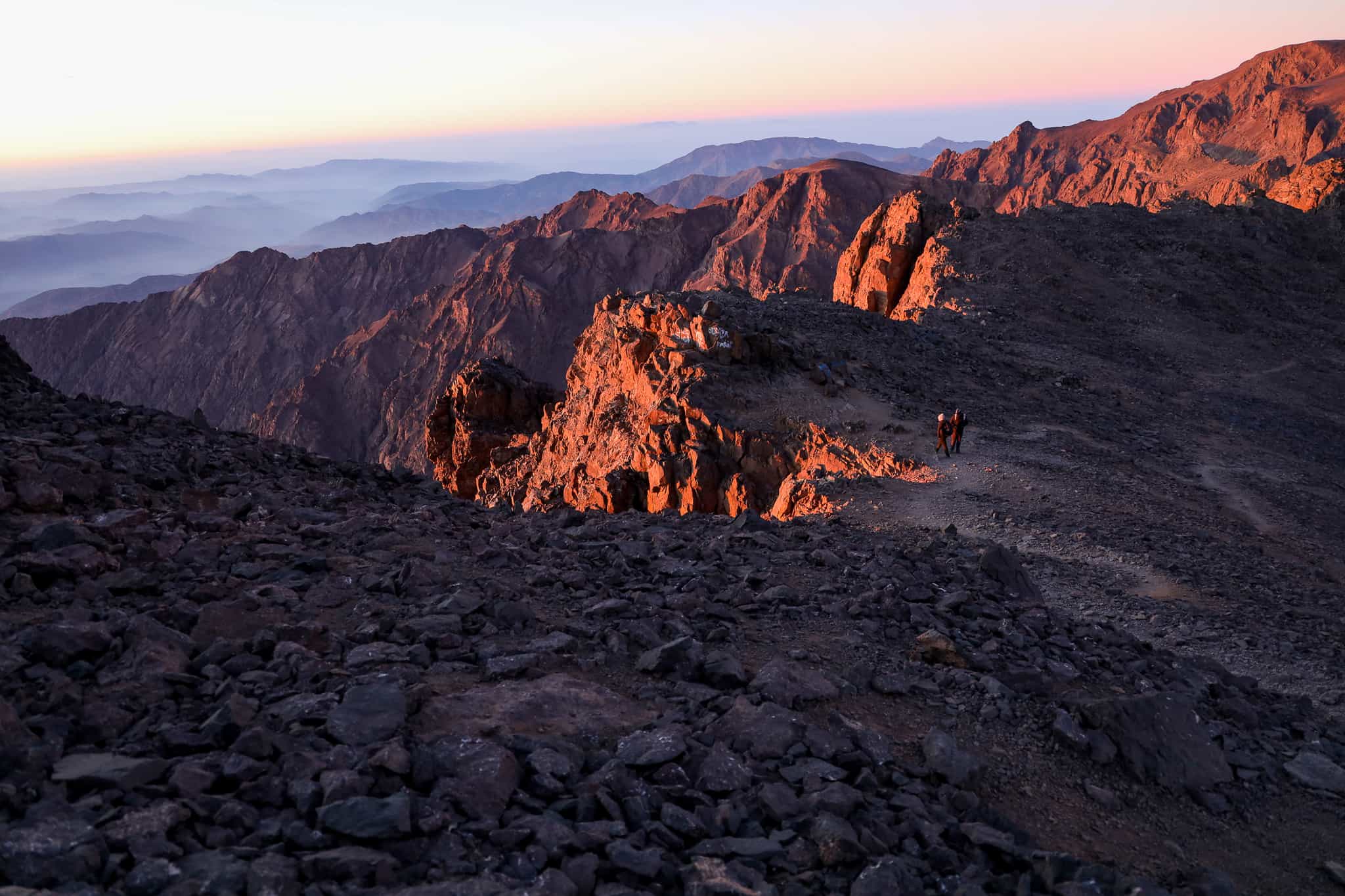
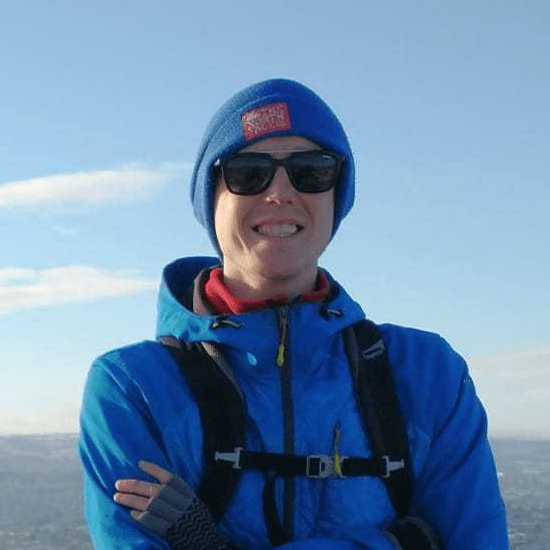
Need help finding flights?
From logistics and how to get there, to fitness, group dynamic and trip difficulty, Rory and his team of friendly experts are on hand to help.
We've got your back
Guaranteed to run
All Much Better Adventures trips are now guaranteed to run. Once you’ve booked your spot you can immediately make your travel arrangements, no uncertainty, no hanging about (excludes 'request to book' departures). Full details
Flexible payments
Secure your spot with the minimum deposit and pay off the remaining balance in as many instalments as you like, with no interest or fees. Full details
Happiness Guarantee
We’re so confident you’ll have an amazing time we’ll put our money on it. Full details
Full financial protection
To give you complete peace of mind Much Better Adventures is backed by ABTOT, ABTA and ATOL memberships. Full details
Tried & Trusted
Much Better Adventures is rated ‘Excellent’ on Trustpilot with over 1000 verified trip reviews averaging 4.8/5.
Connect before you go
You'll be invited to join a WhatsApp group to get to know each other before your big adventure together. Full details
DEPARTURE DATES
Saturday 27th September 2025
to Saturday 11th October 2025
Hurry; only 3 spaces left
